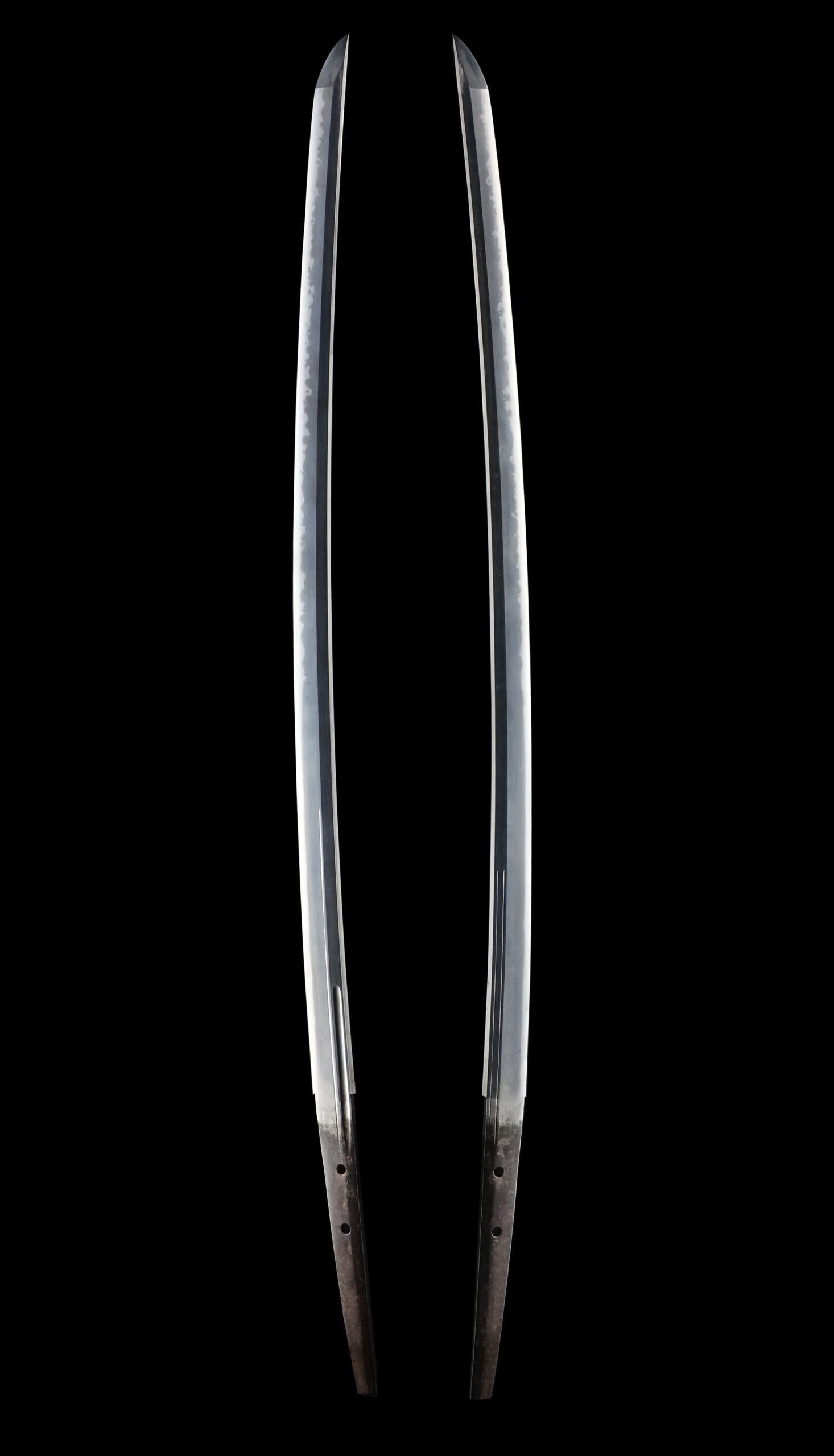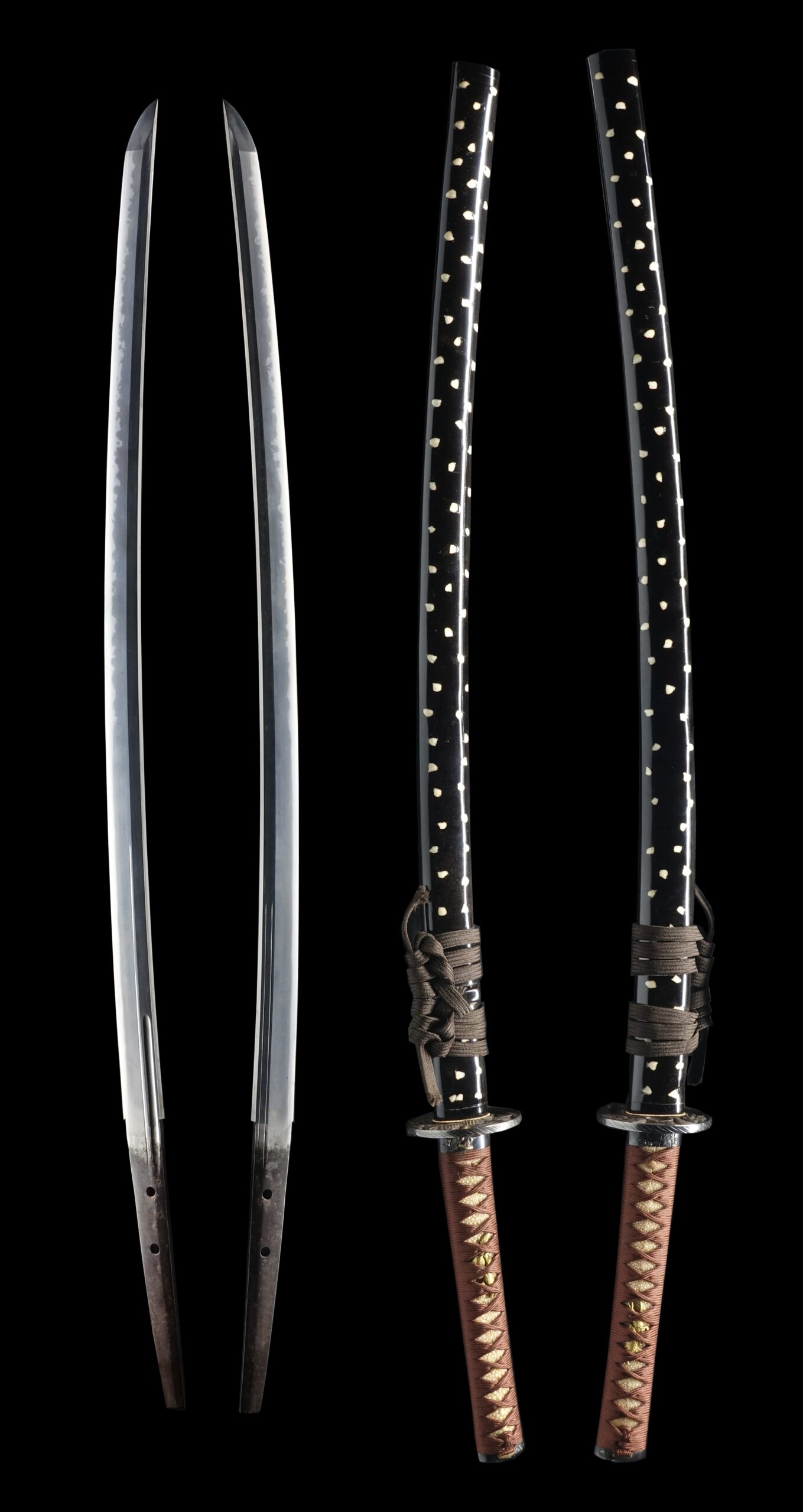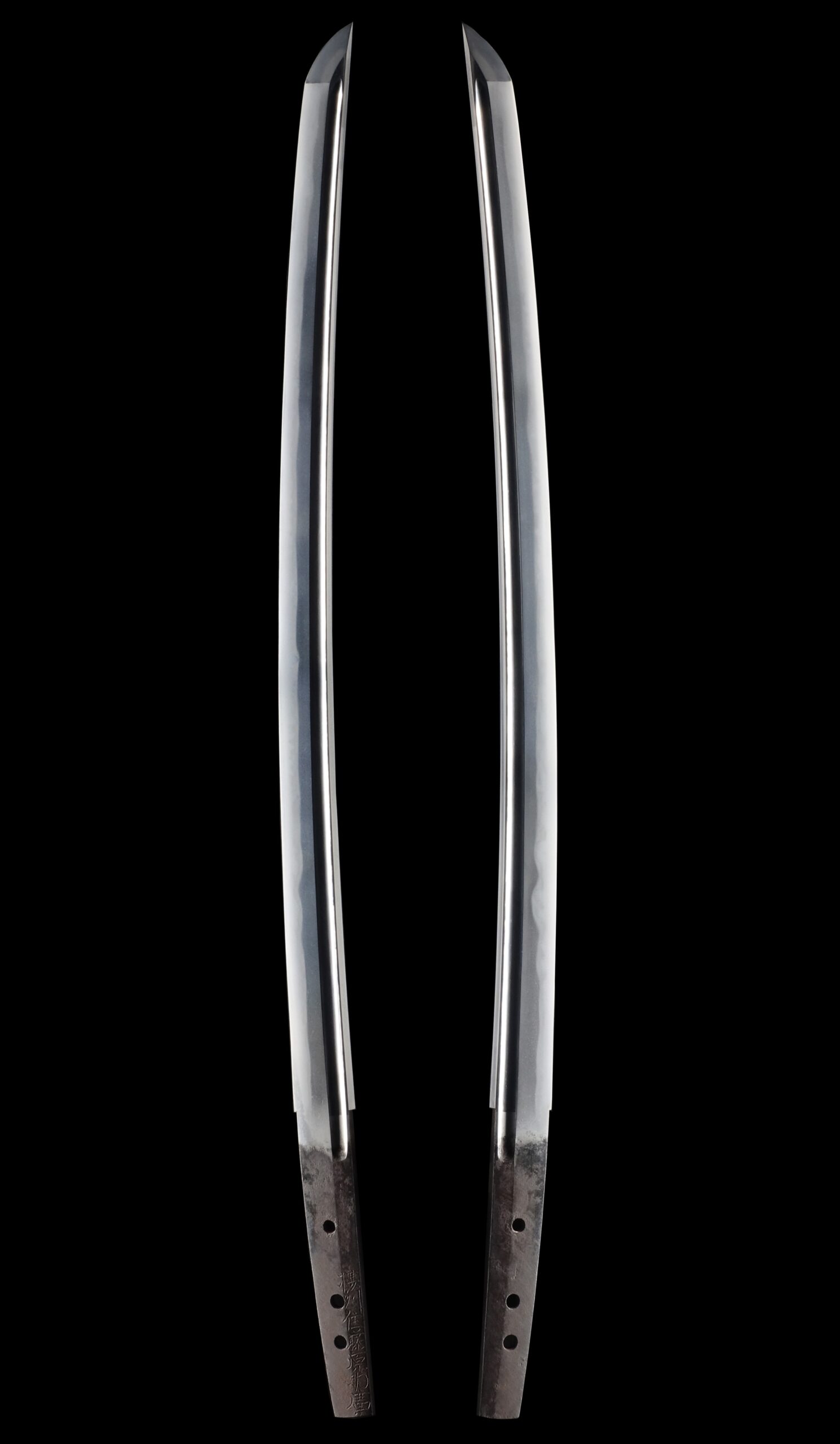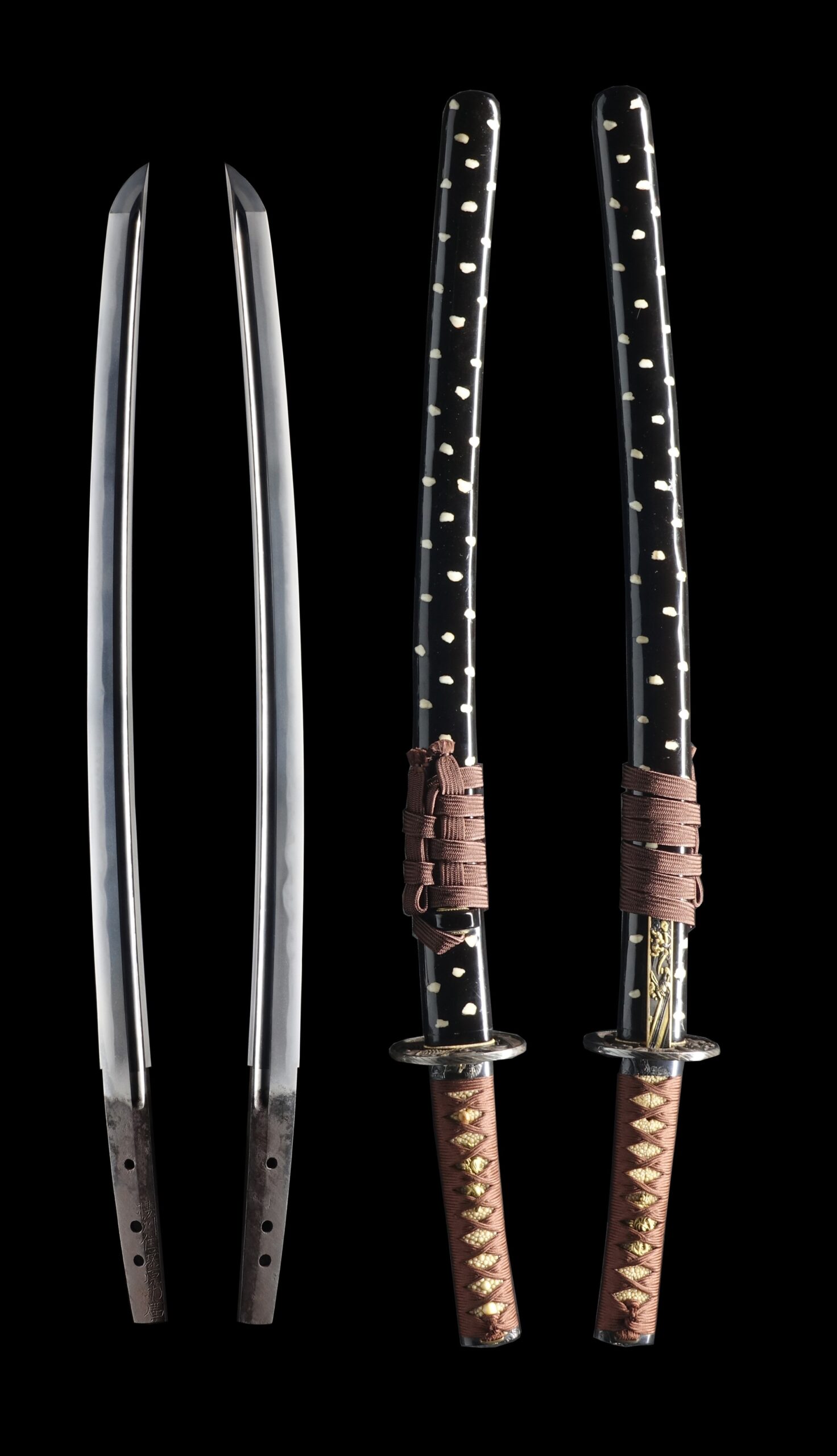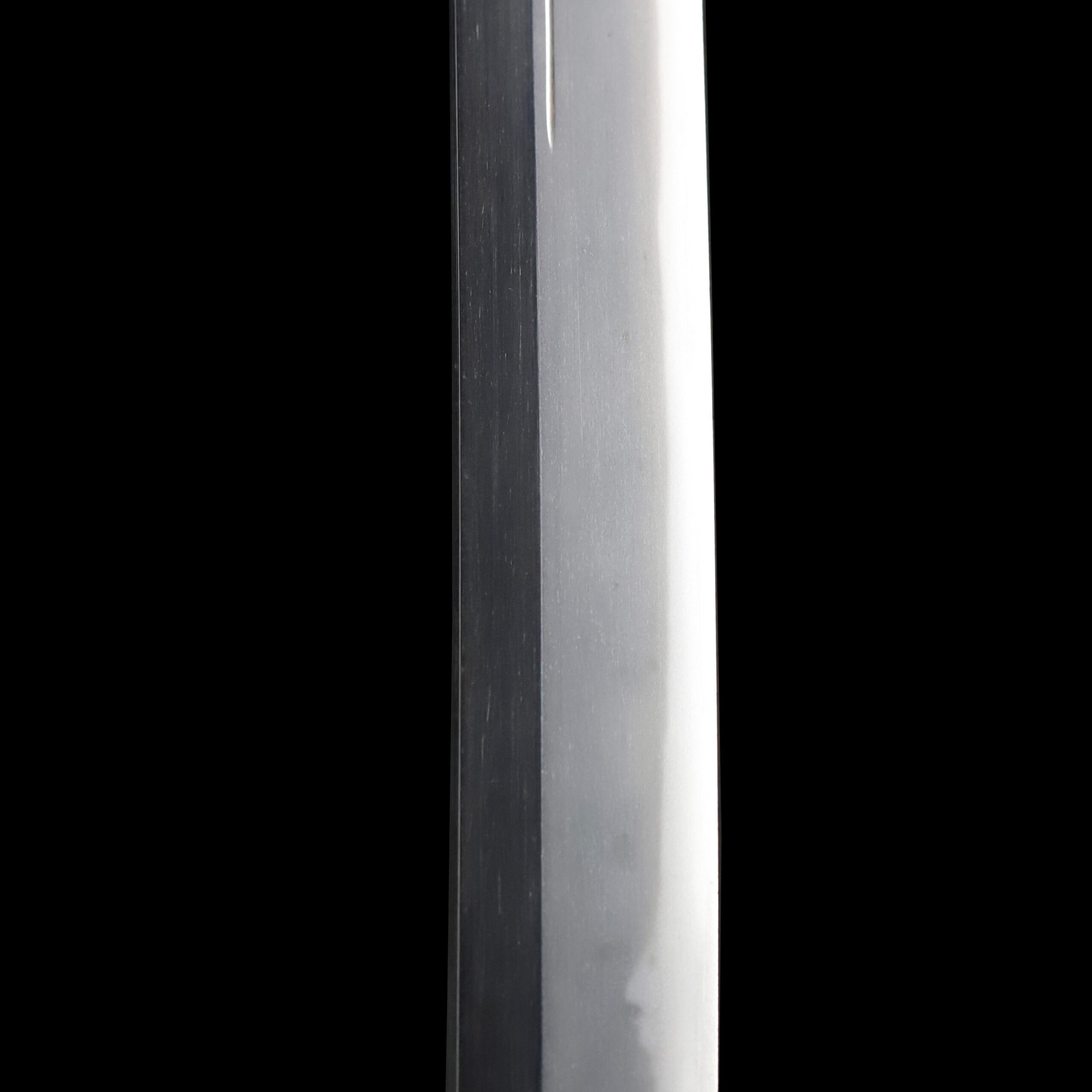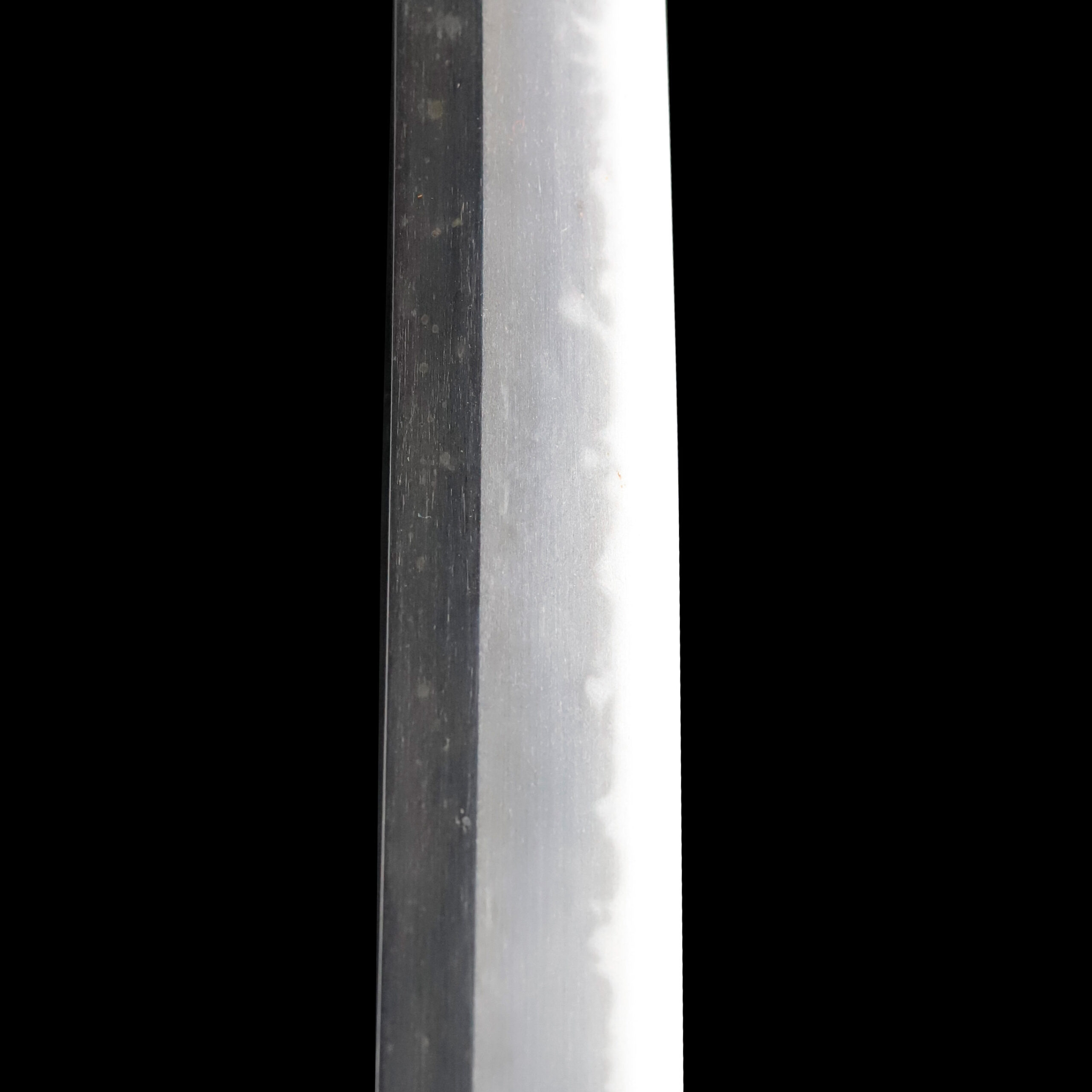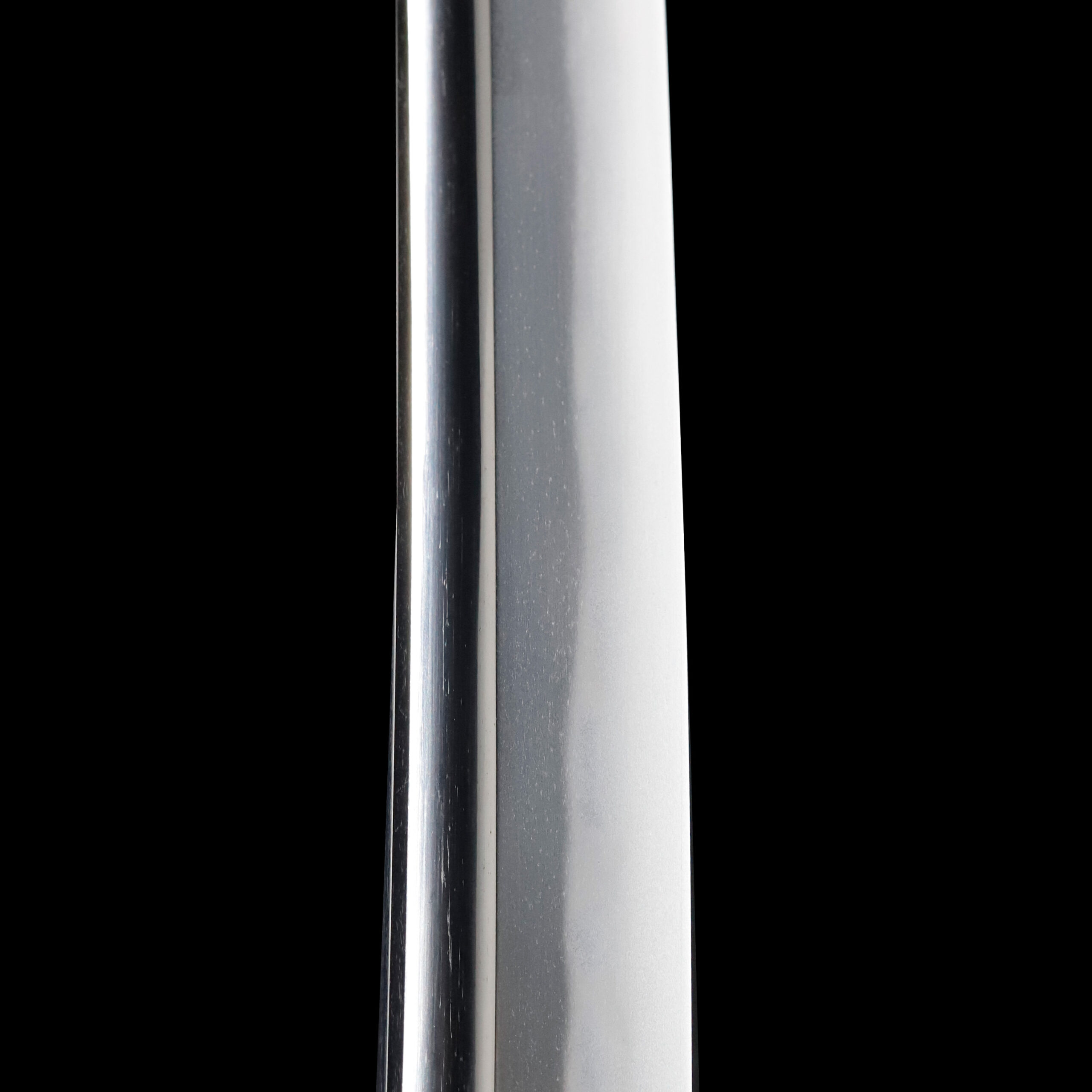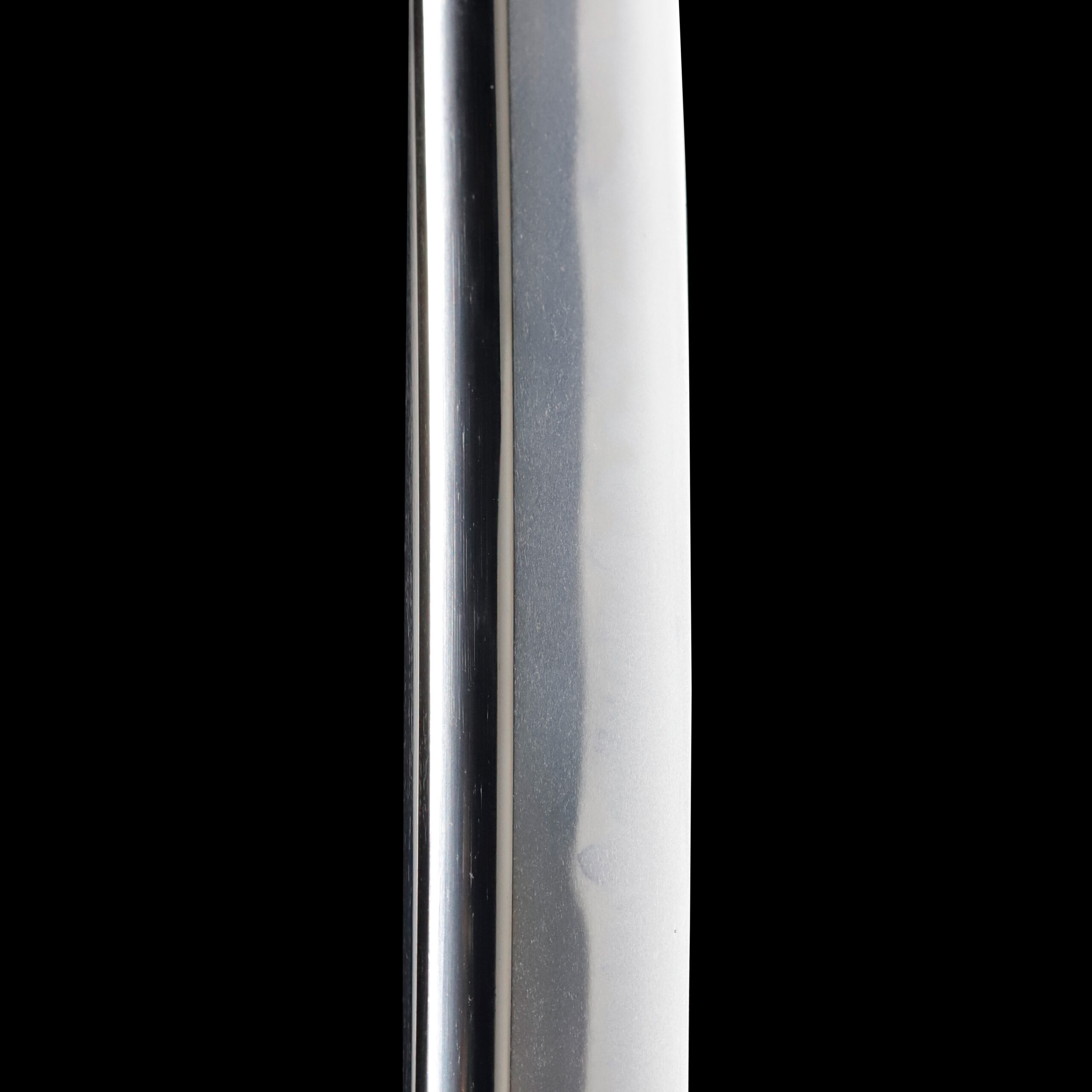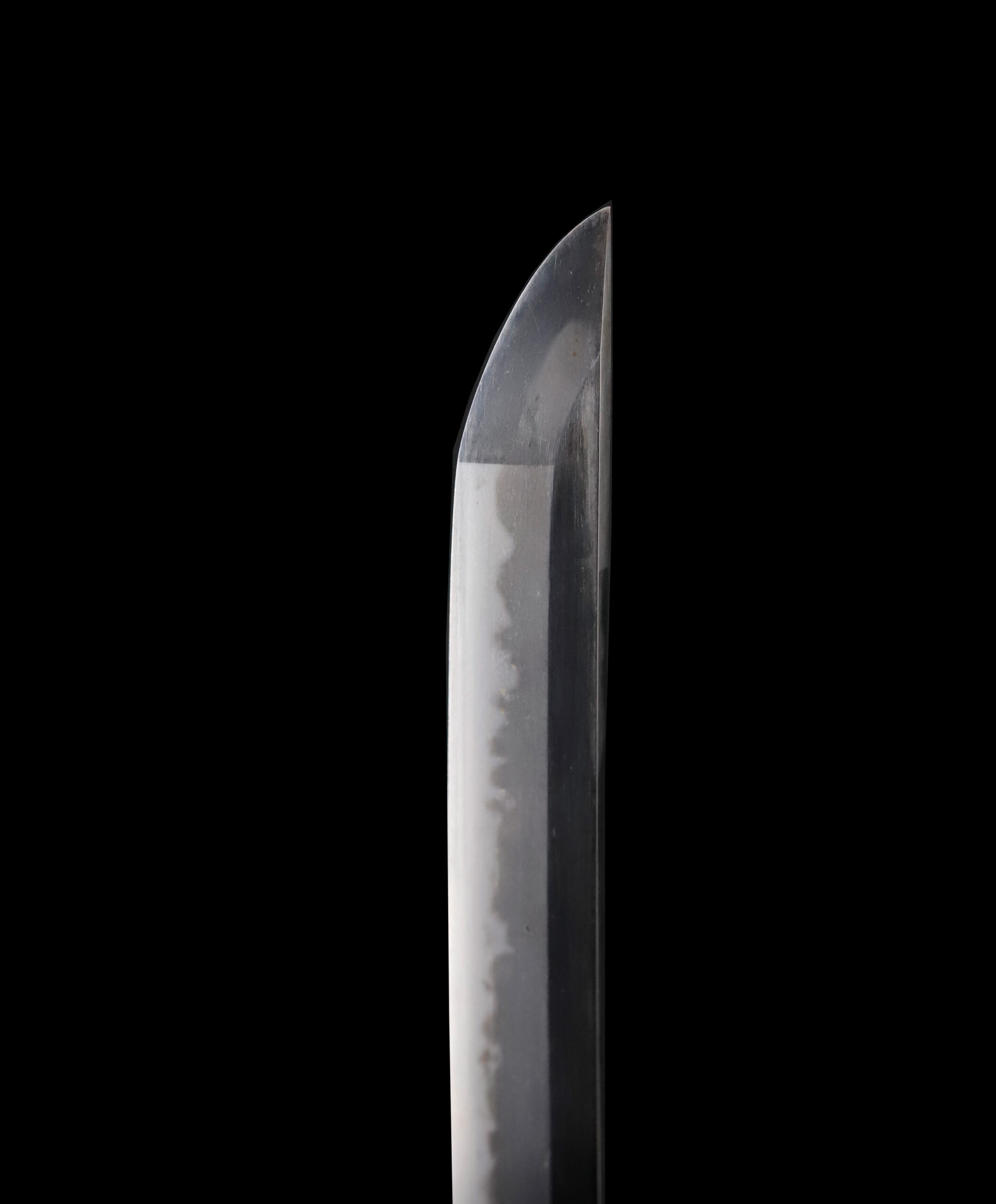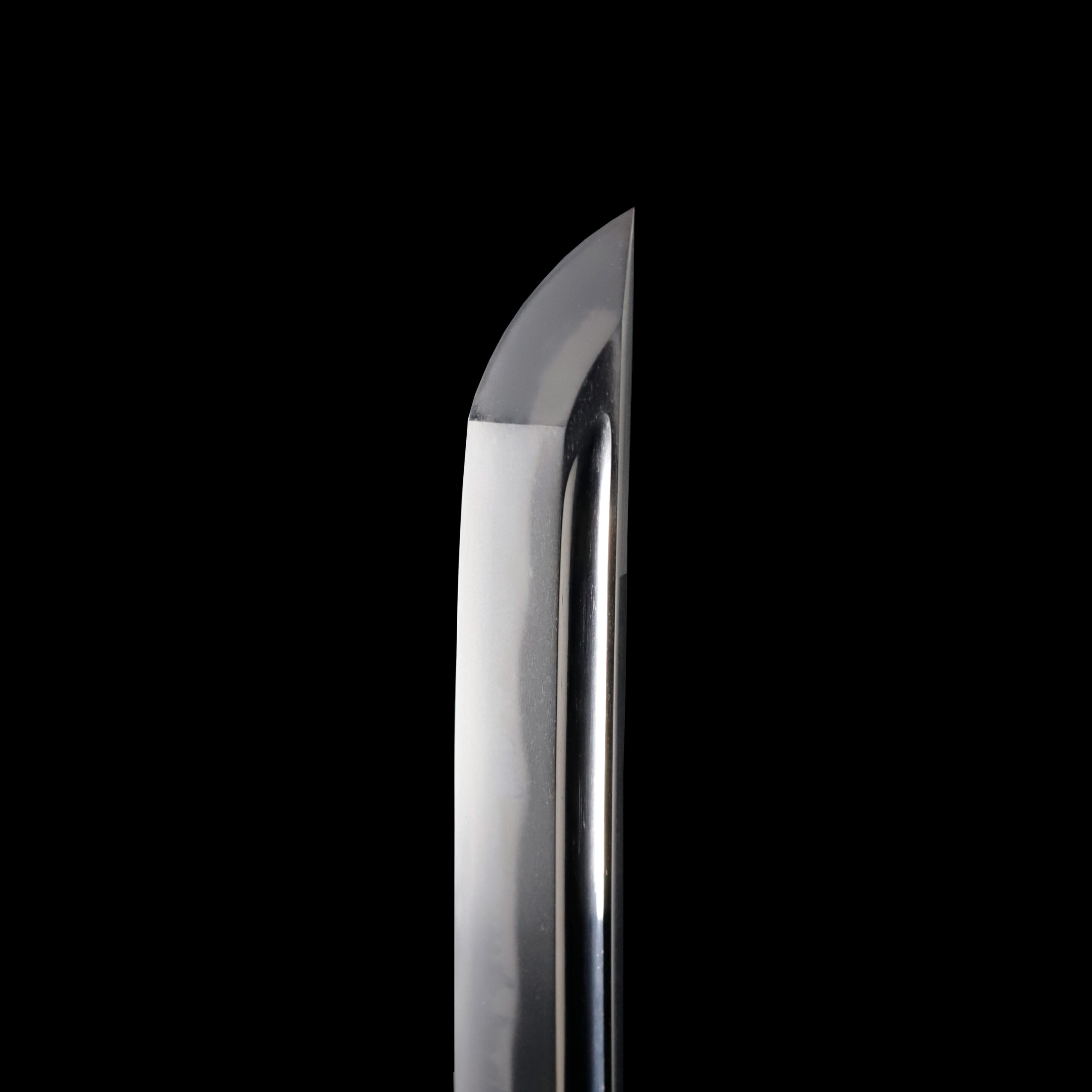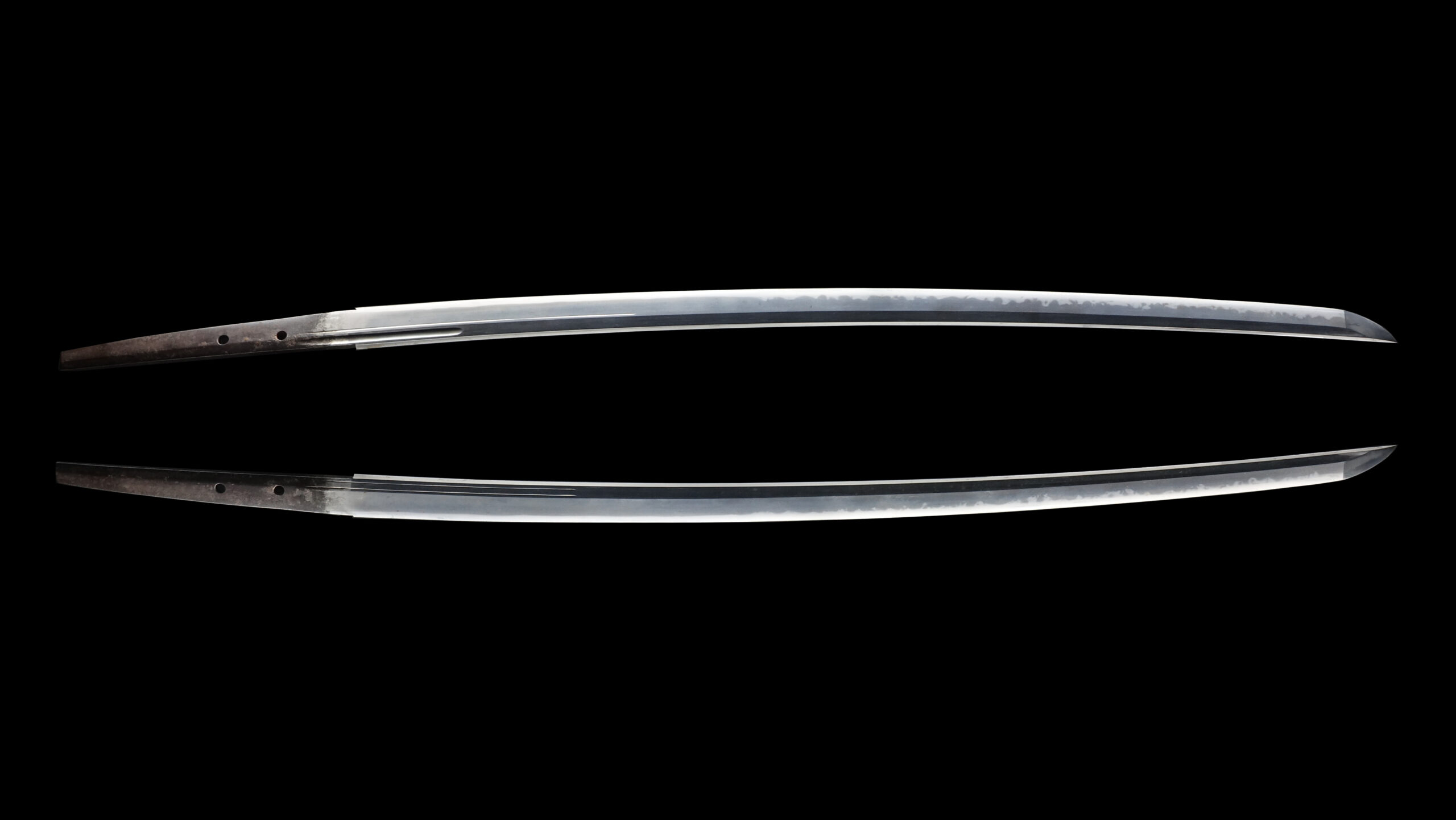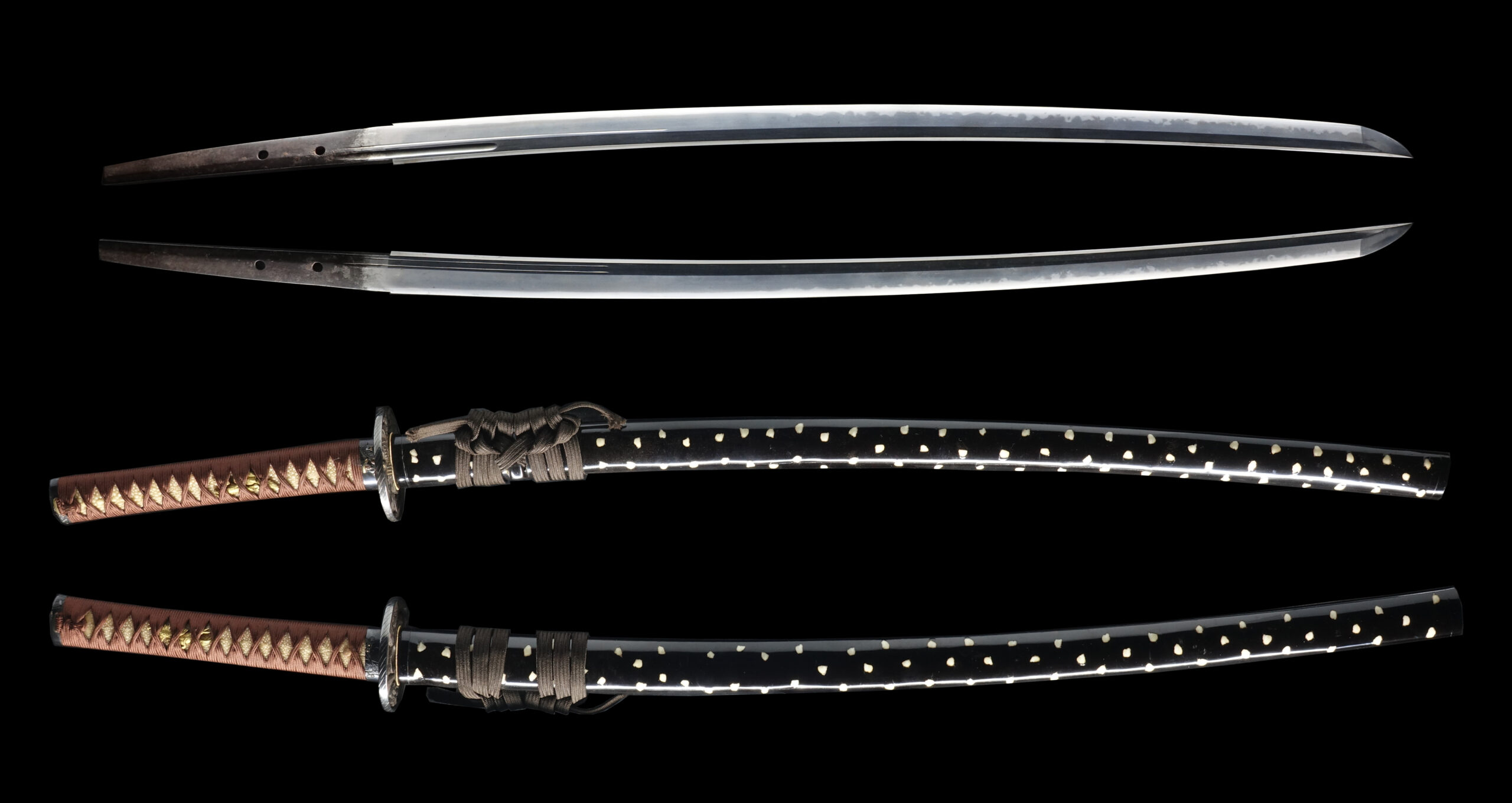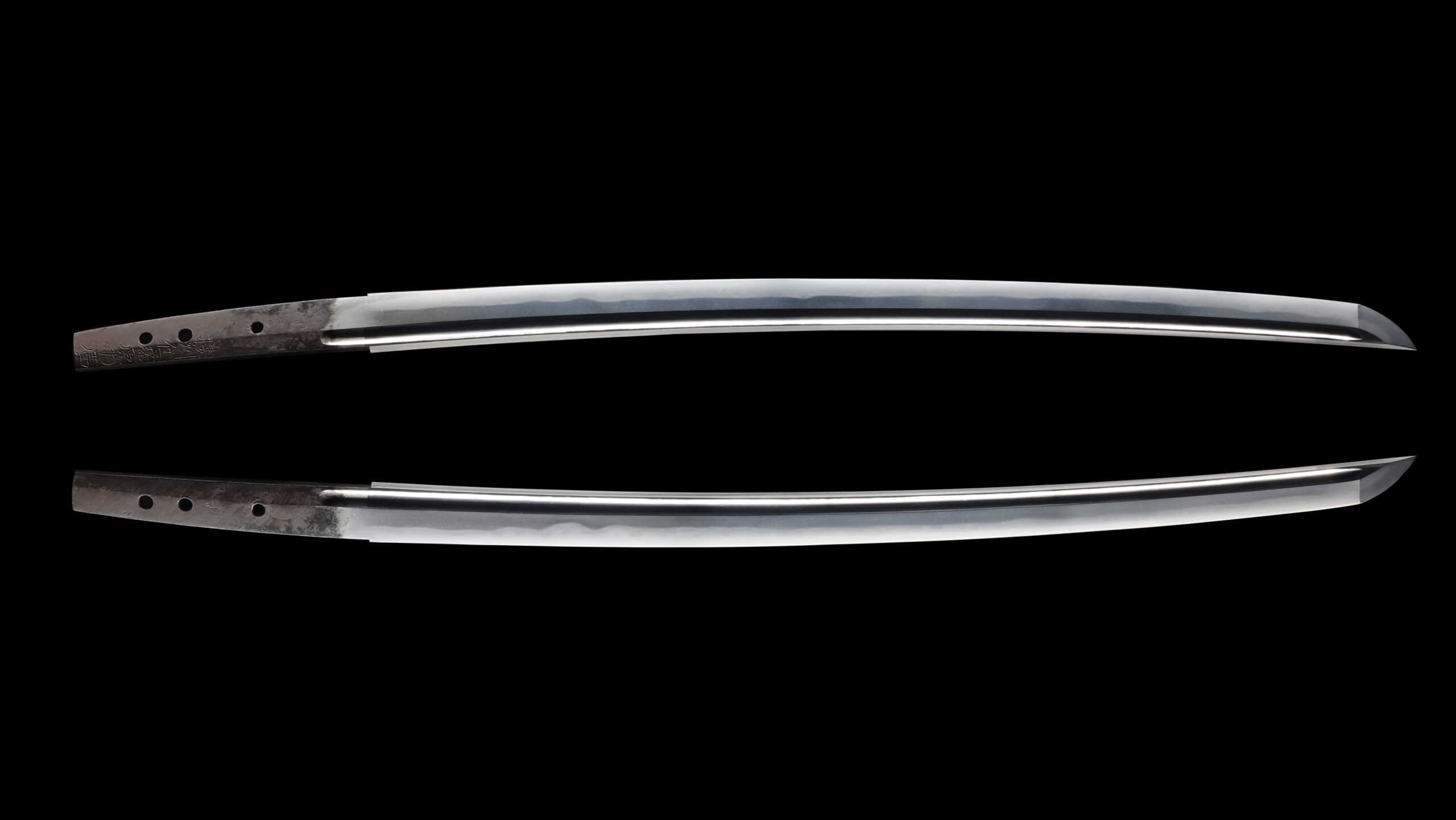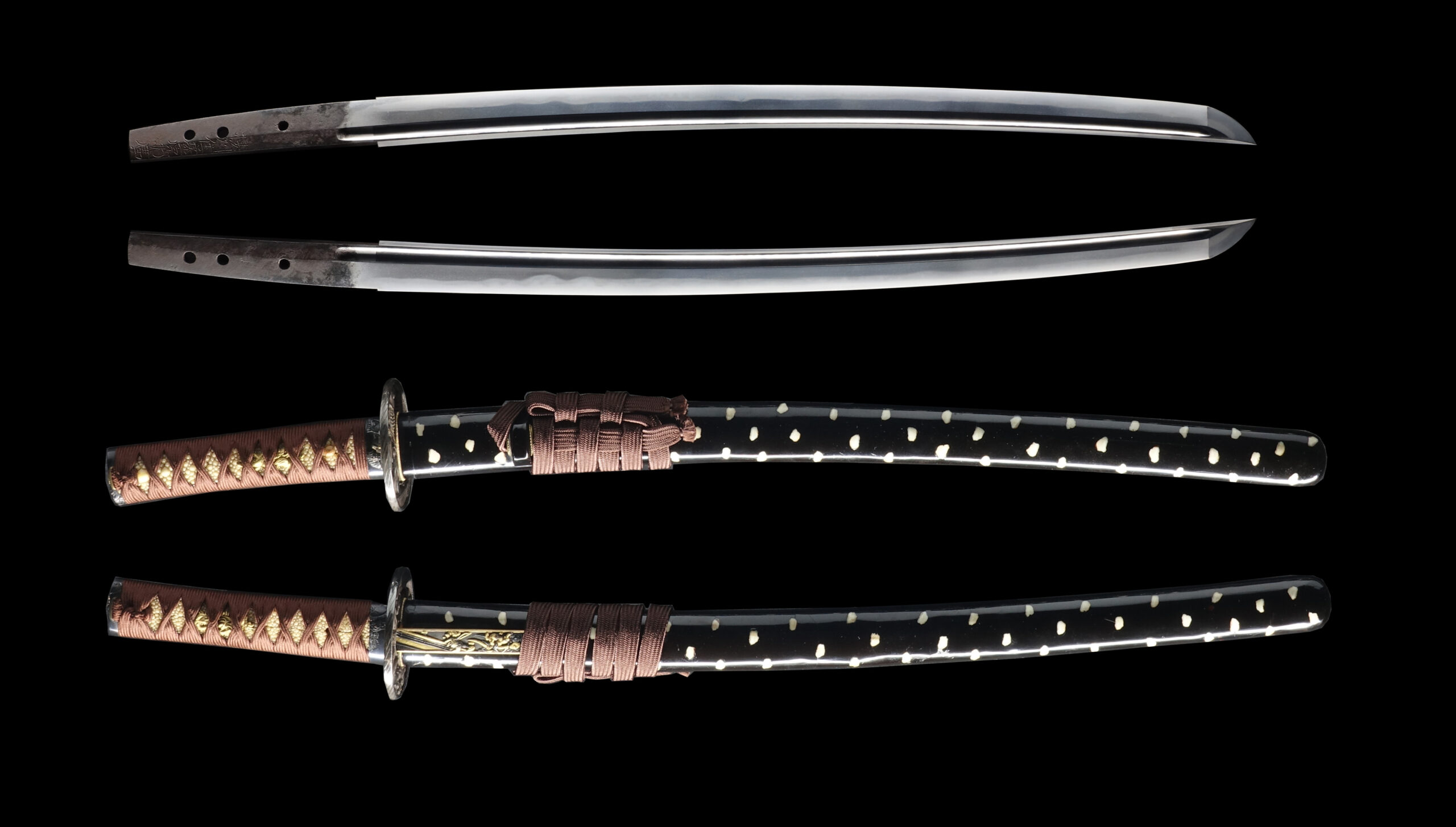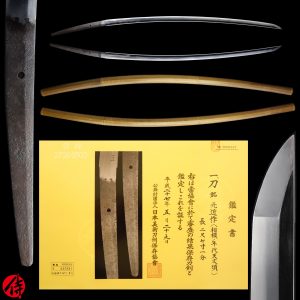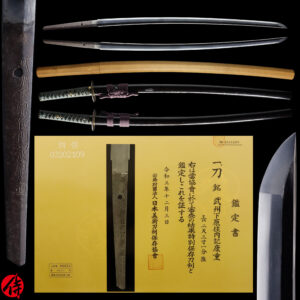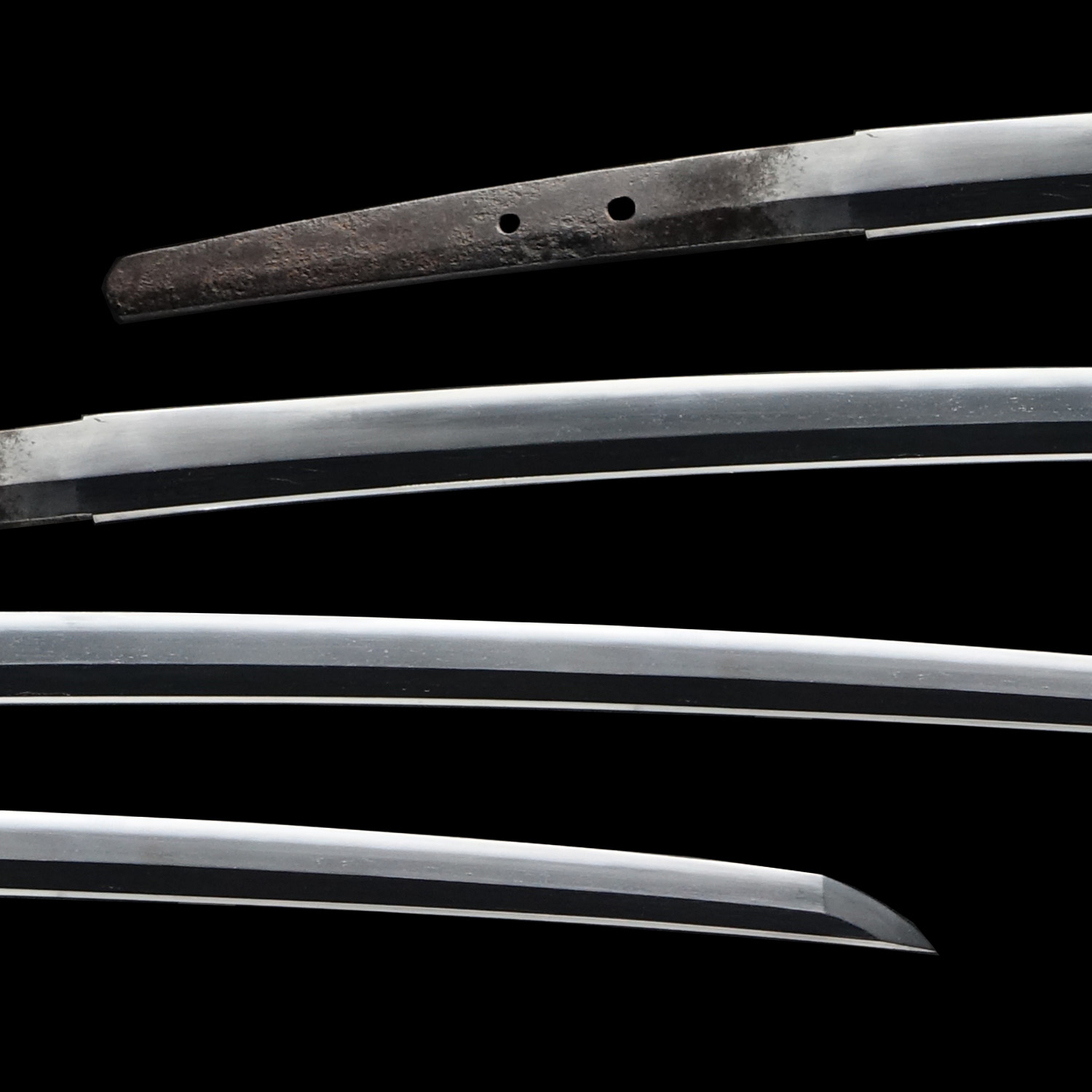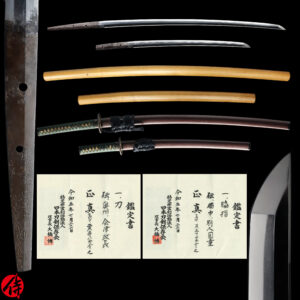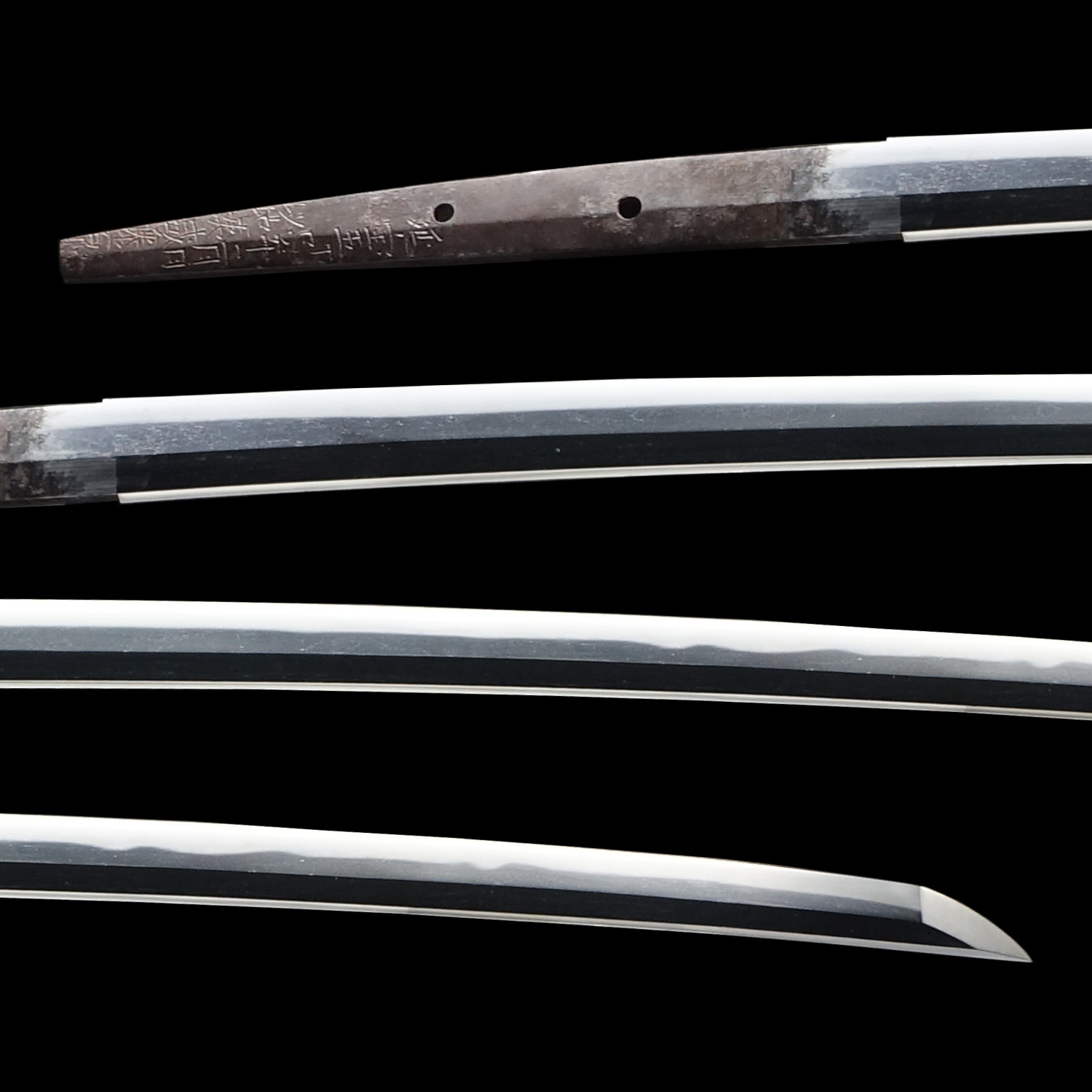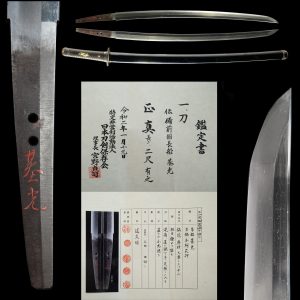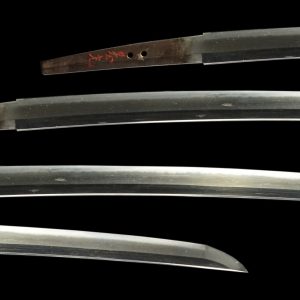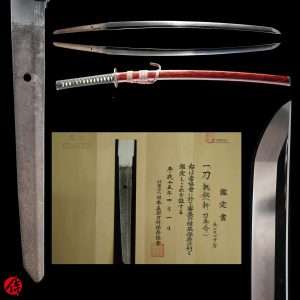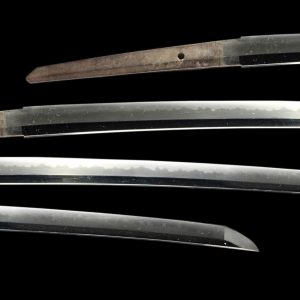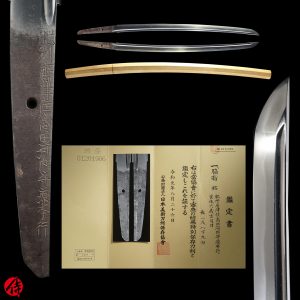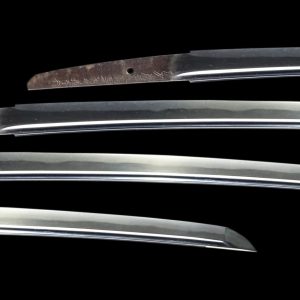Antique Japanese Sword Daisho Attributed to Takada Muneyuki/Signed by Sukehiro with NBTHK Hozon Certificate and Tokubetsu Hozon Certificate
【Description】
-Katana
This blade is attributed to Takada Muneyuki (高田統行), who belonged to a prestigious school named Takada(高田). The maker’s name Tokiyuki lasted three generations from the Tensho to Meireki era (1573-1658). We believe the attribution was given to the first generation, who was active during 1573-1615 (Azuchi Momoyama- early-Edo period).
Takada school was founded by Takada Tomoyuki in Takada village, Bungo domain (Ohita prefecture), during the Nanbokucho period. (1334-1338 A.D). Takada Tomoyuki went to Bizen province(today’s Okayama prefecture) to master the sword-forging techniques of BIZEN and returned to the village and trained his apprentices. That is how Takada school started.
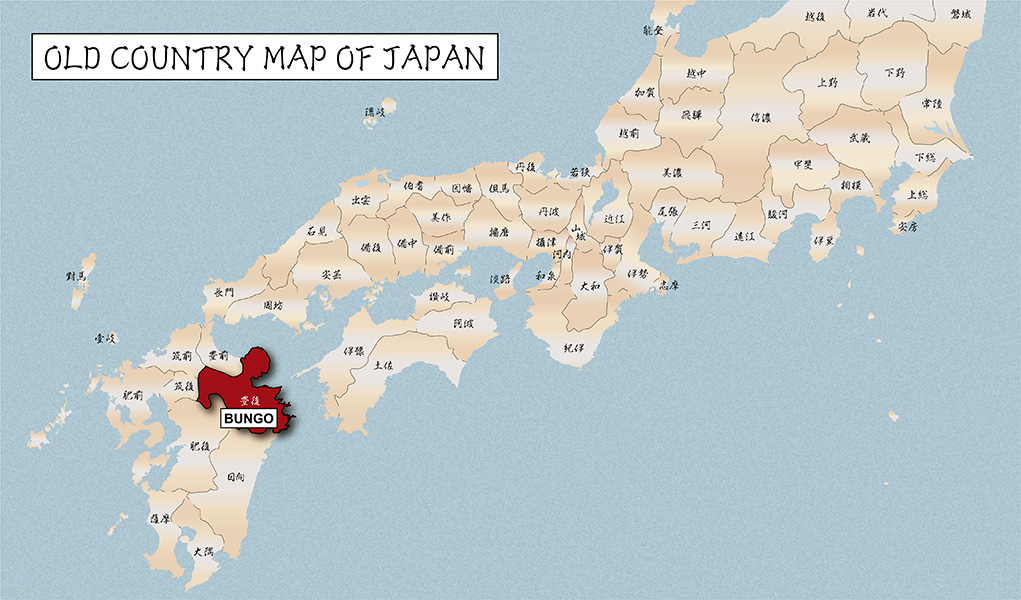
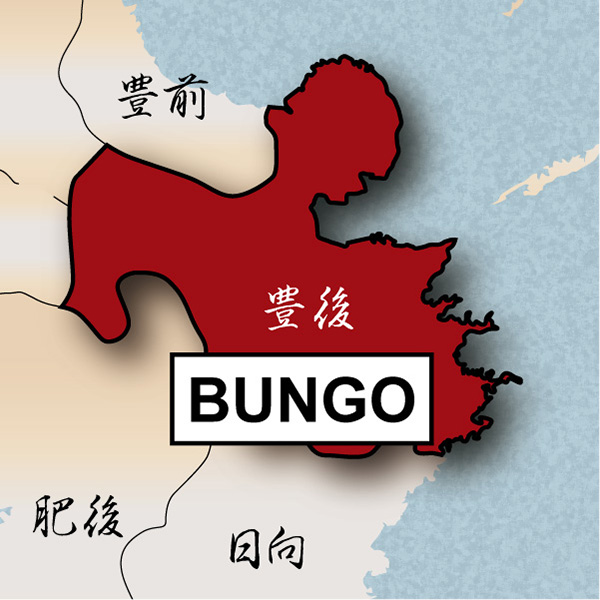
During Sengoku Period (the warring state period: from late 15 C to late 16 C), the Takada school forged many swords for many Samurais in Kyushu island. It is said that the reputation of the blades forged by Takada school was close to MINO or BIZEN swords, two of which are the most famous sword forging places.
The Bungo domain was ruled by Otomo Yoshishige (Sorin) during the Sengoku period. Yoshishige and his domain built a strong military and political base there. Yoshishige was known as one of the most famous warlords on Kyushu island. It is said that Takada swordsmiths forged swords for those who served the Otomo clan and Muneyuki received 統 letter, one of his maker’s name from Otomo family. And, Muneyuki played an important role to make Takada school prosperous during the Edo period.
Generally speaking, Kyushu island was prosperous in sword-making because of its long trading history with Asian countries. Many feudal lords on this island fought against each other to gain an advantage in trading. Takada school received many orders as the demand increased among those lords.
The material of Japanese swords(high-quality iron sand and charcoal) was abundant in mount Sobo Katamuki, located near Takada village. We believe Takada school prospered because of its geographic location and natural resources.
-Wakizashi
This blade was signed by Setsushu Jyu Fujiwara Sukehiro (摂州住藤原助広), who was active during the Kanei-Keian era (1624-1652: Early Edo period). Setsushu is another name for Settsu province (today’s Osaka prefecture). Setsushu Jyu means that Sukehiro resided in this area when he forged the blade.
The maker’s name Sukehiro lasted three generations, and this blade was made by the first generation, according to its NBTHK’s appraisal. The first-gen Sukehiro was one of Osaka’s most skilled and influential swordsmiths in the early Edo period (Mid-Late 17th century). He was originally born in Tsuda City, Harima province (today’s Hyogo prefecture). Later, he moved to Osaka to become an apprentice of Kawachi no Kami Kunisuke, a renowned swordsmith in Osaka. The first-gen Sukehiro was also famous for being the father of Tsuda Echizen no Kami Sukehiro, one of the most prestigious swordsmiths during the early Edo period.
According to the book (Kaihou Kenjyaku) published by Yamada Asaemon in the late Edo period, a blade forged by the first-gen Sukehiro was ranked as Saijo Owazamono (extremely outstanding sharpness). Asaemon was hired by the Edo government as an expert on Tameshigiri, or testing cutting. And in this book, he judged how sharp Japanese swords forged by prestigious swordsmiths were.
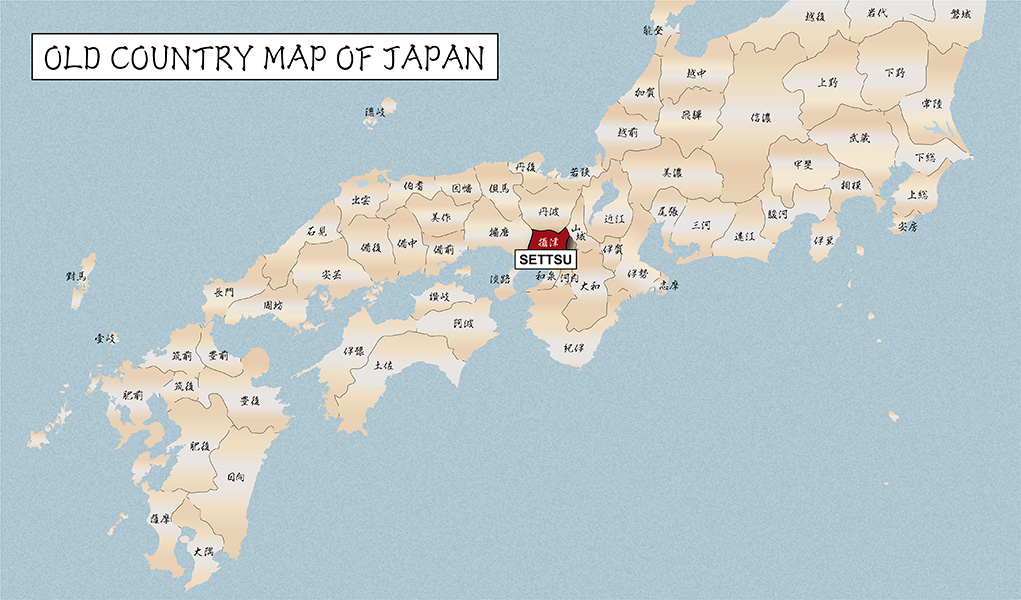
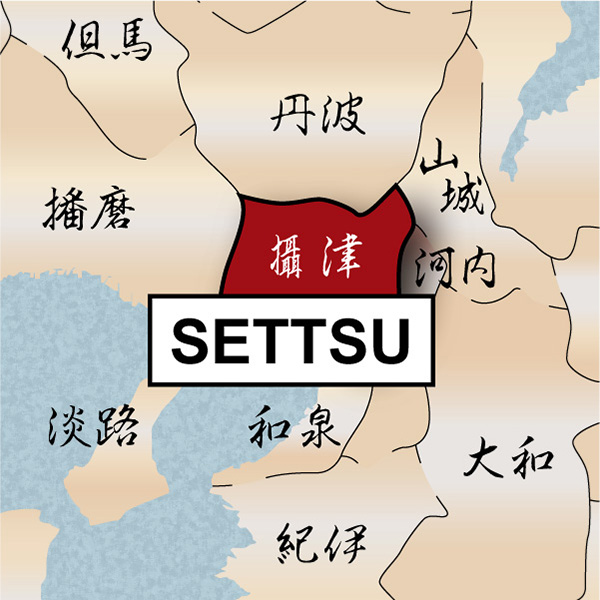
Osaka Shinto
The blades forged by Sukehiro are categorized as Osaka Shinto. Shinto is Japanese Sword terminology that refers to the swords forged during 1596-1781. The blades made in the Osaka area during this period are called Osaka Shinto. There are many famous swordsmiths in this Osaka Shinto era. After Hideyoshi Toyotomi built Osaka castle, Osaka city flourished as a castle town and became the business center. Many swordsmiths moved to Osaka to look for better opportunities. They not only forged swords for those Samurai who lived in Osaka but also for feudal lords nationwide. Tsuda Sukehiro, Ikanshi Tadatsuna(Awataguchi Omi no Kami Tadatsuna), and Inoue Shinkai are the most famous among many swordsmiths.
One of the most notable characteristics of Osaka Shinto is its beauty in Jigane. Jigane is a visible steel surface pattern created by folding and hammering during the forging process), which made it possible by the location of Osaka. Osaka had close access to the Tamahagane(special carbon steel to make Japanese swords) production sites. The swordsmiths residing in Osaka could get high-quality carbon steel from these sites.
What is Daisho?
Daisho is a pair of two Japanese swords Samurai carried. During the Edo period, having Daisho in public places was considered social status for Samurai. Furthermore, Samurai were required to wear them under the law back then. Daisho is written as 大=Big and 小=Small. Dai part means Katana, and Sho part means Wakizashi. We are confident you would find this pair of Daisho Koshirae gorgeous.
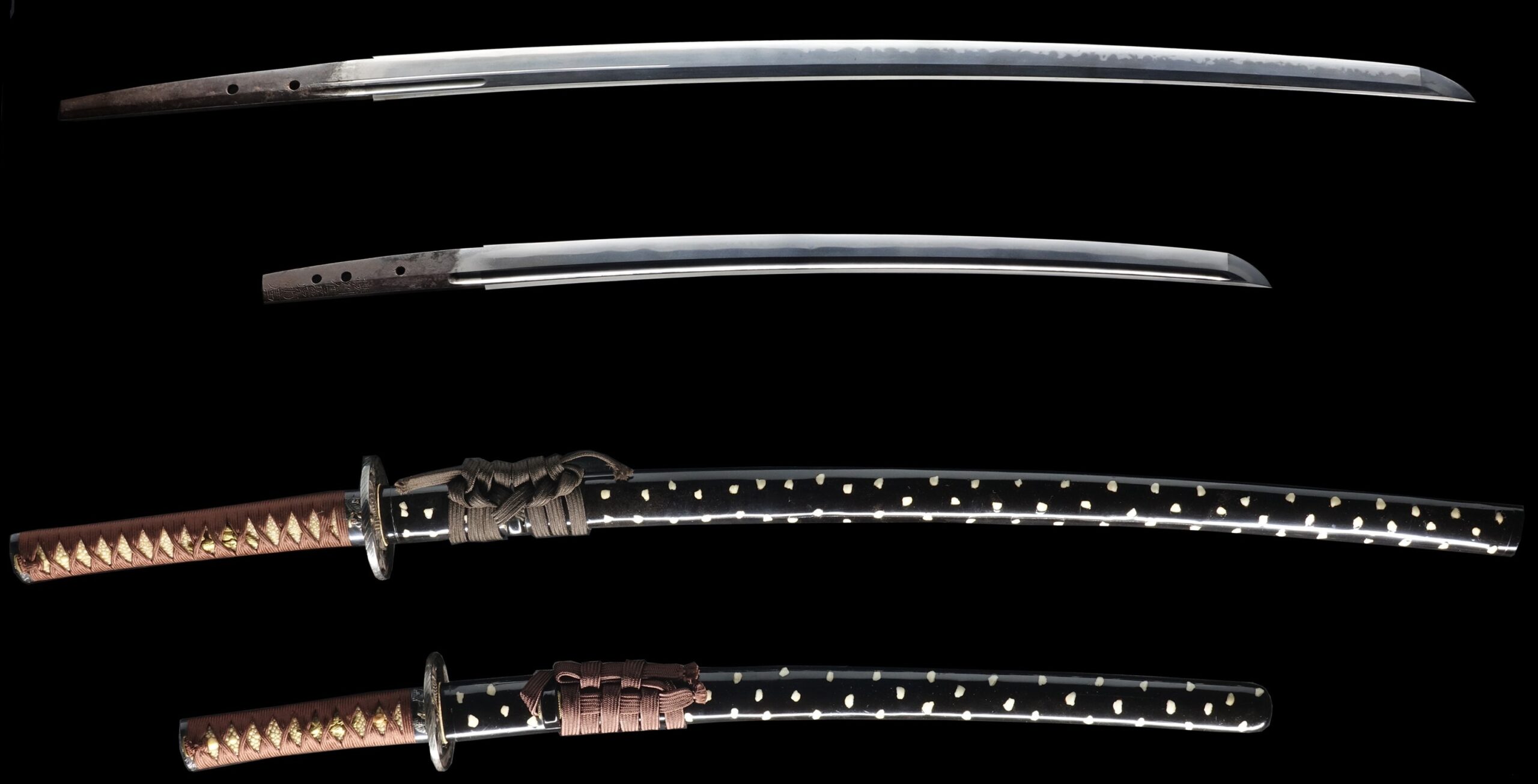
Appraisal
This Katana blade is appraised as a Hozon Token(保存刀剣) and this Wakizashi is appraised as a Tokubetsu Hozon Token (特別保存刀剣). They were issued by NBTHK (Nihon Bijutsu Touken Hozon Kyokai:日本美術刀剣保存協会). These authentication papers were only given to authentic Japanese swords well preserved and high quality with artistic value.
【 Blade】
-Katana
Cutting Edge Length(Nagasa):70.4 cm ( 27.7 inches)
Curvature(Sori):1.4 cm ( 0.55 inches)


-Wakizashi
Cutting Edge Length(Nagasa): 51.4 cm ( 20.2 inches)
Curvature(Sori):1.0 cm ( 0.39 inches)

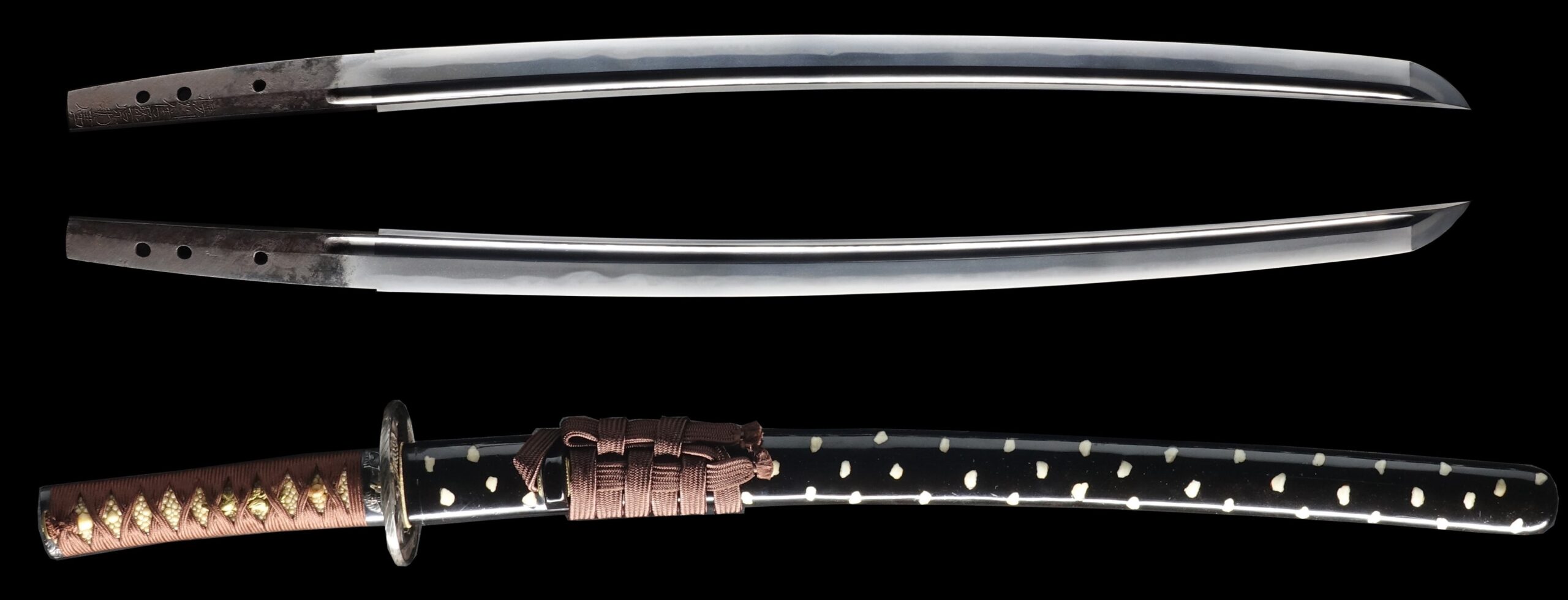
Hamon:
The crystalline structure which forms along the cutting edge of a blade as a result of the hardening process
Jimon(Jihada):
visible steel surface pattern created by folding and hammering during forging process
-Katana
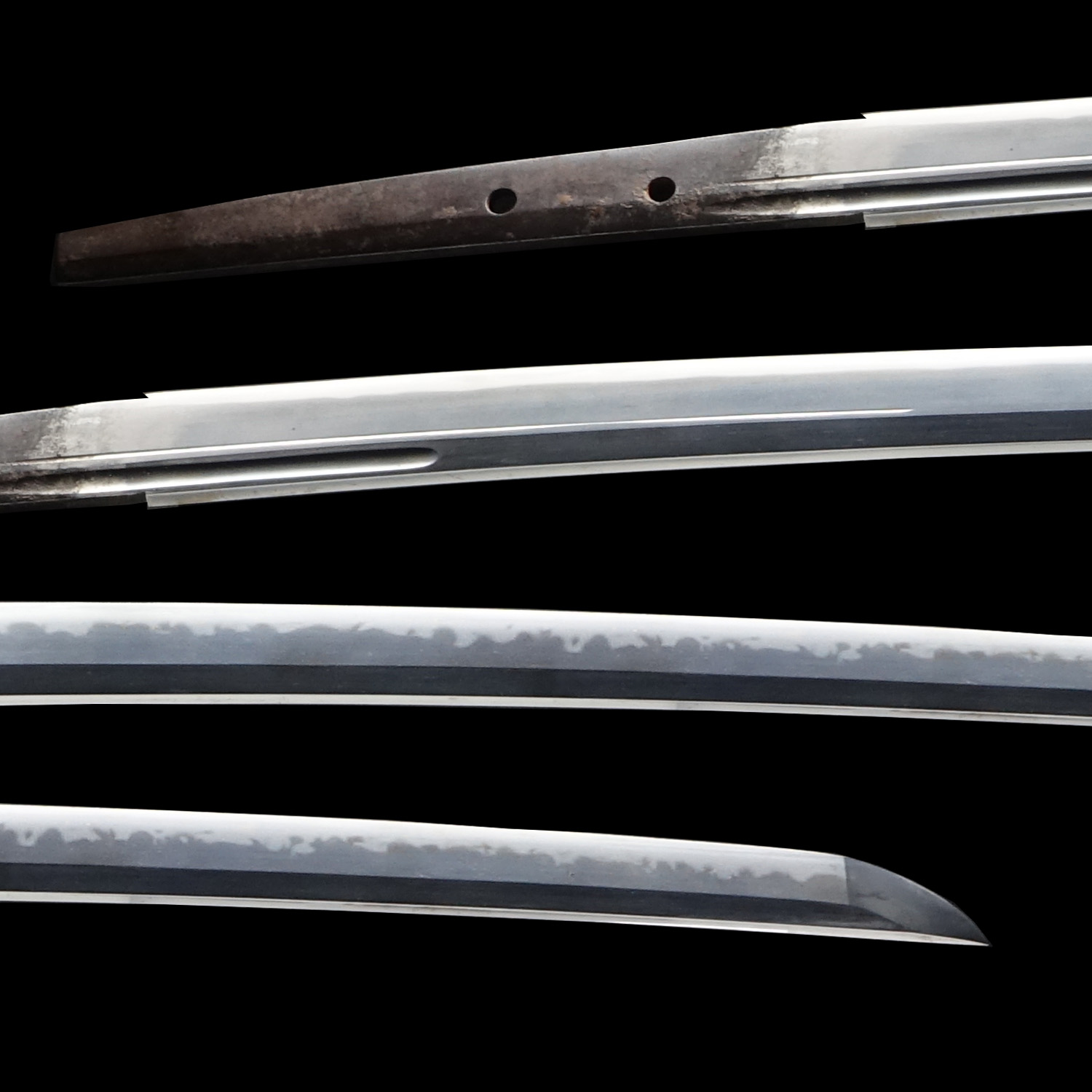
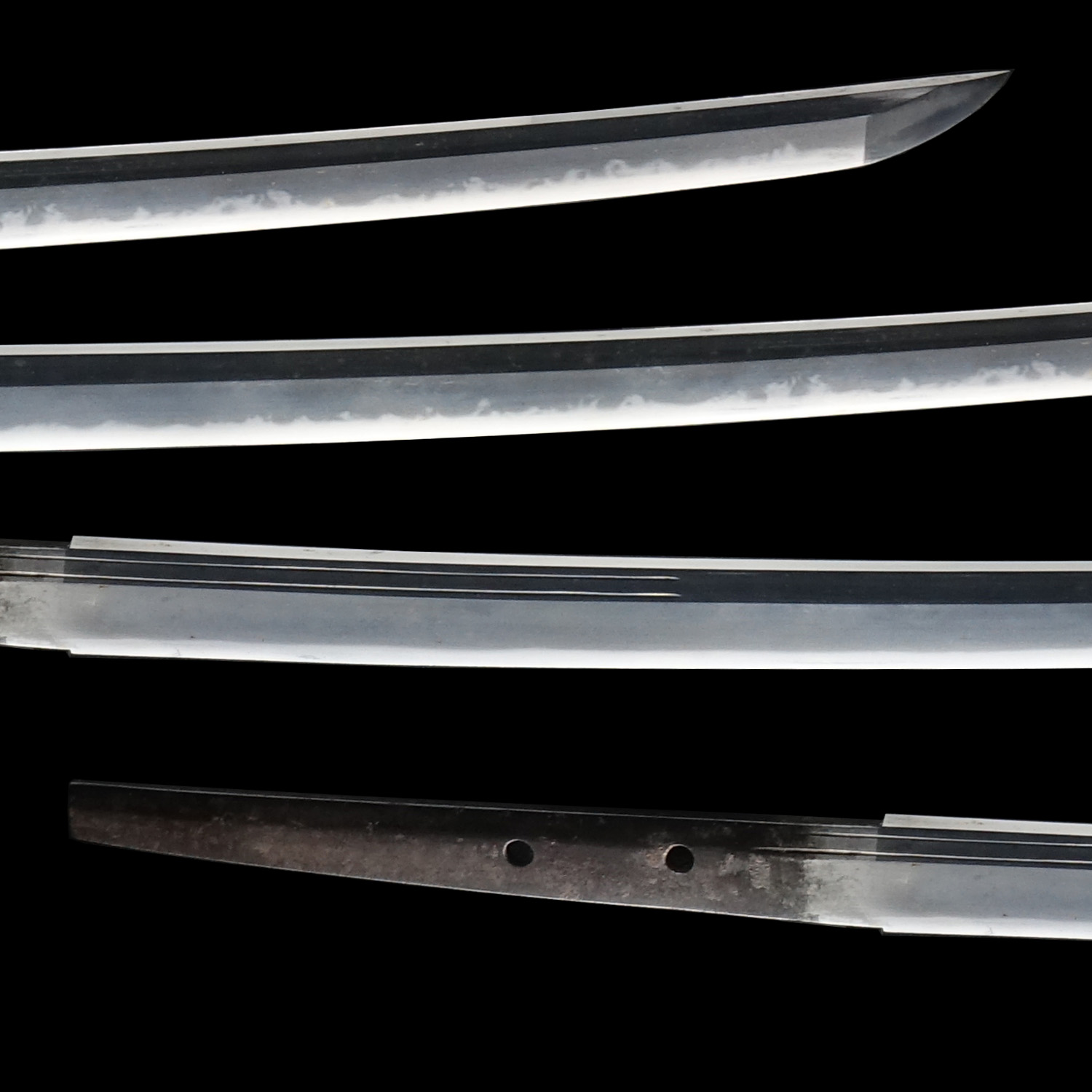
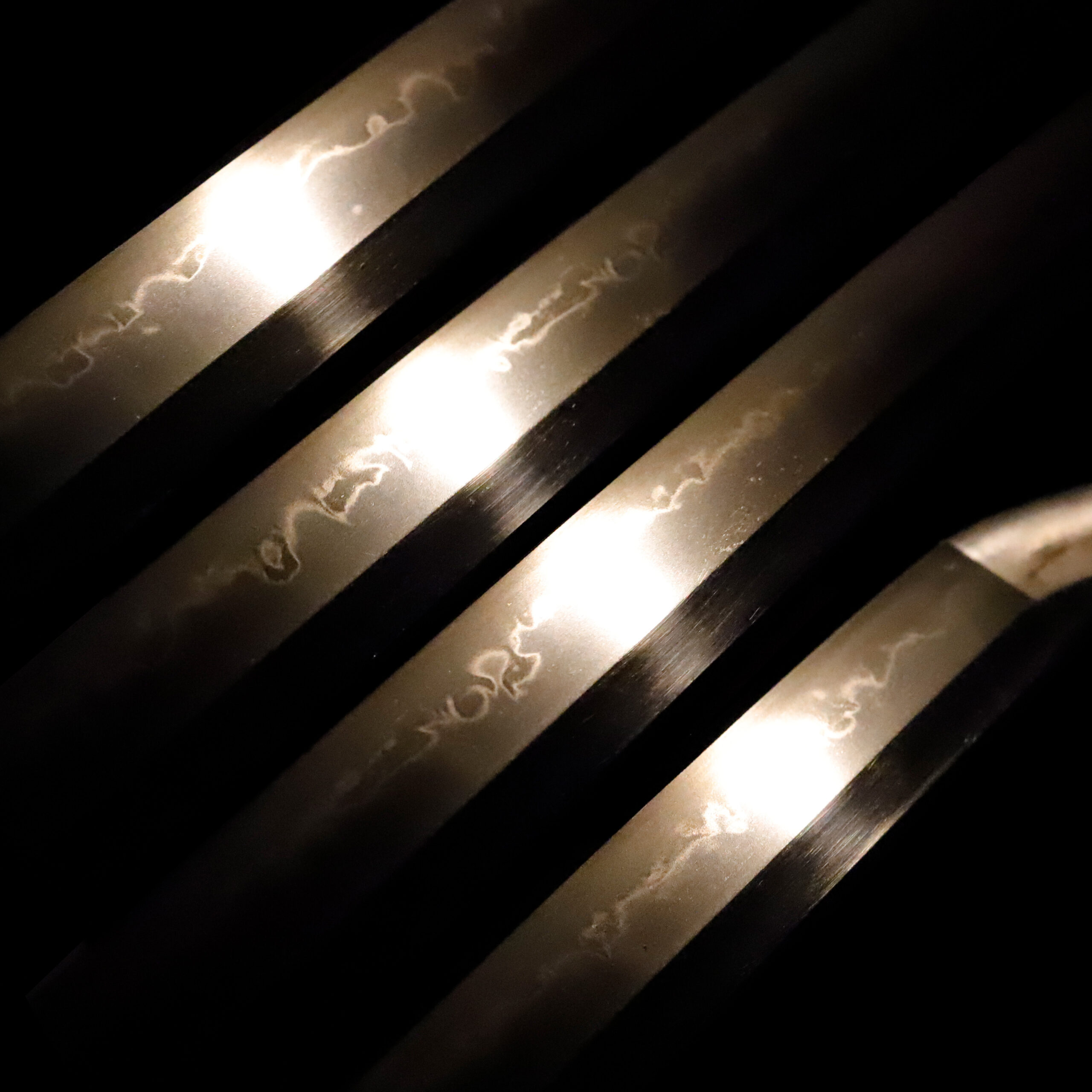
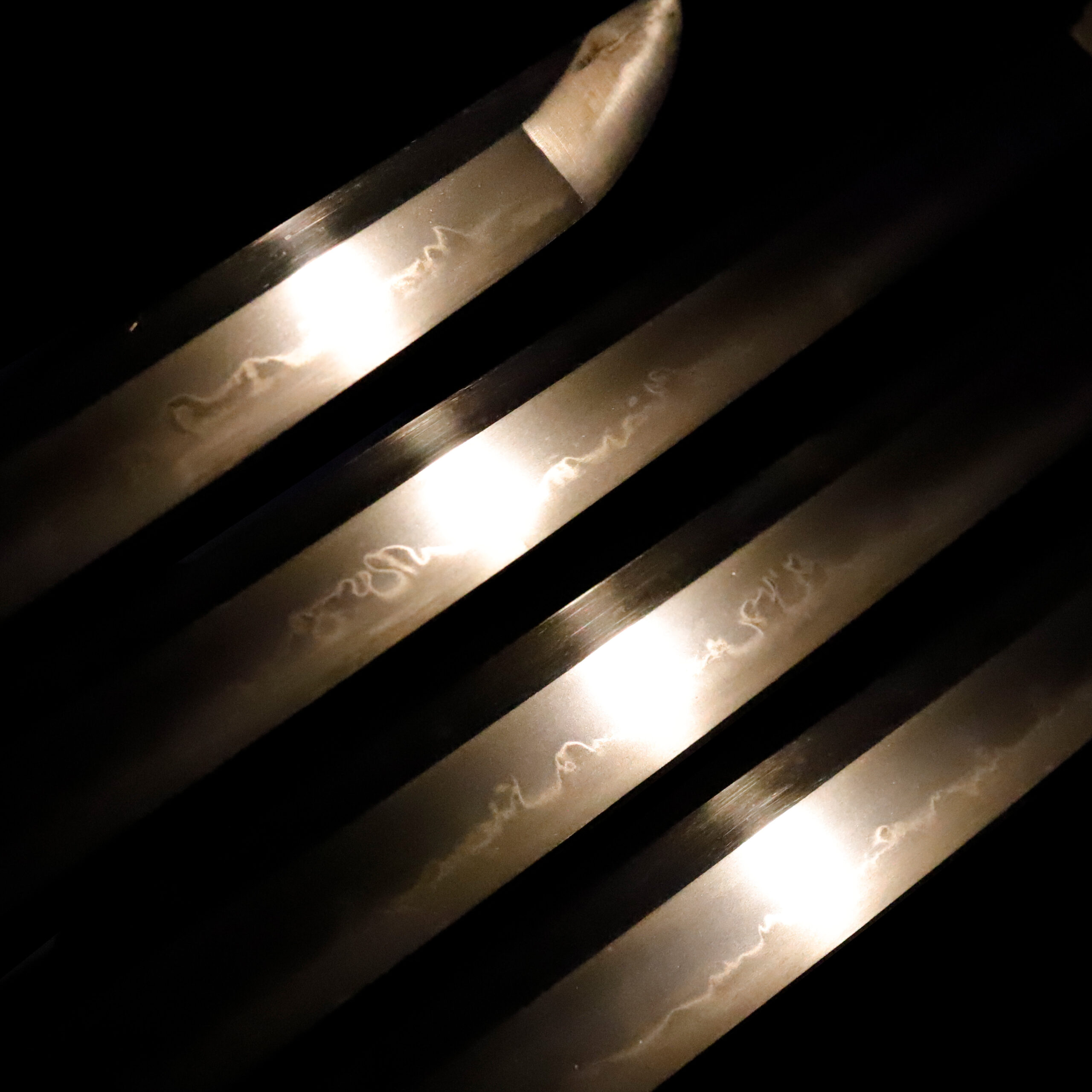
-Wakizashi
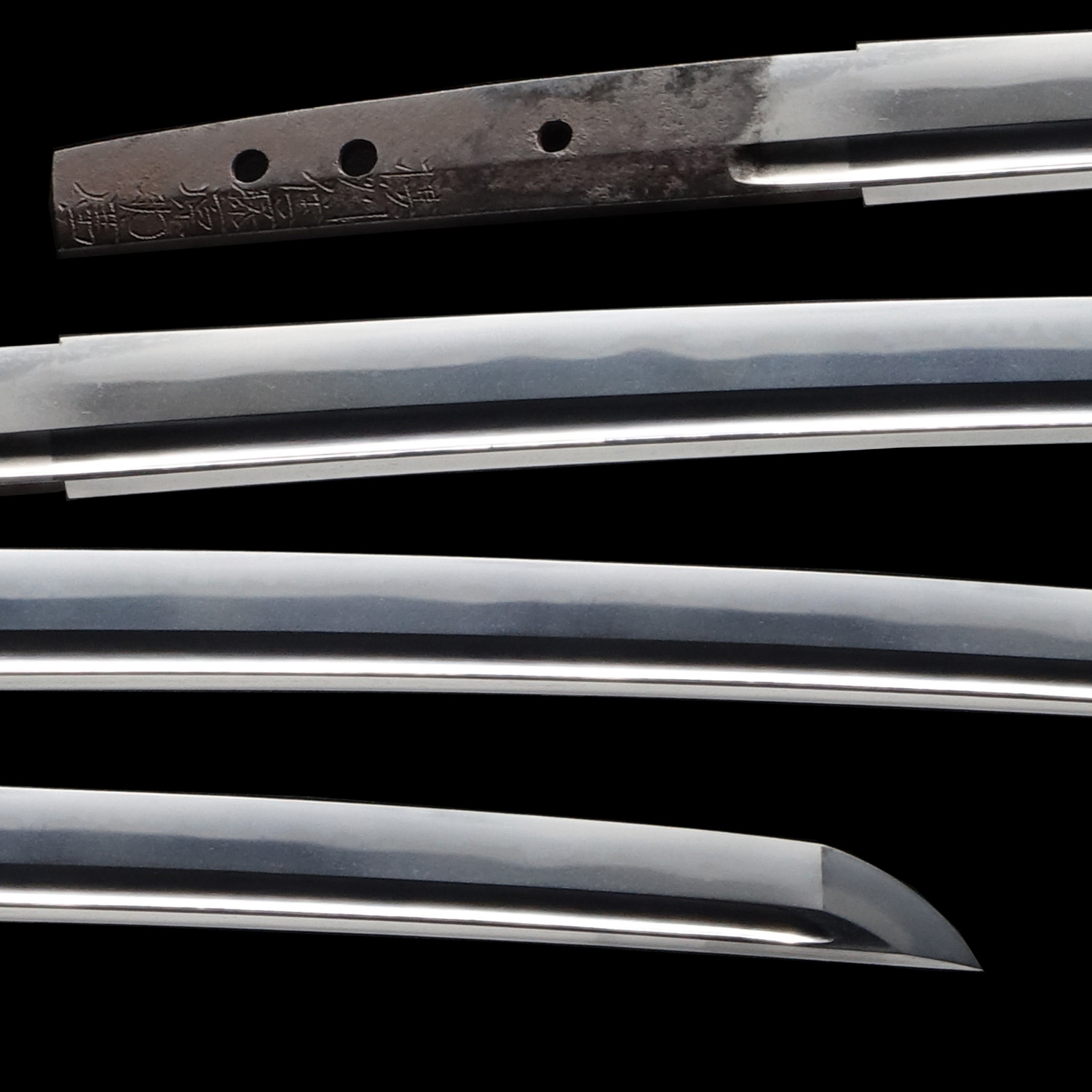
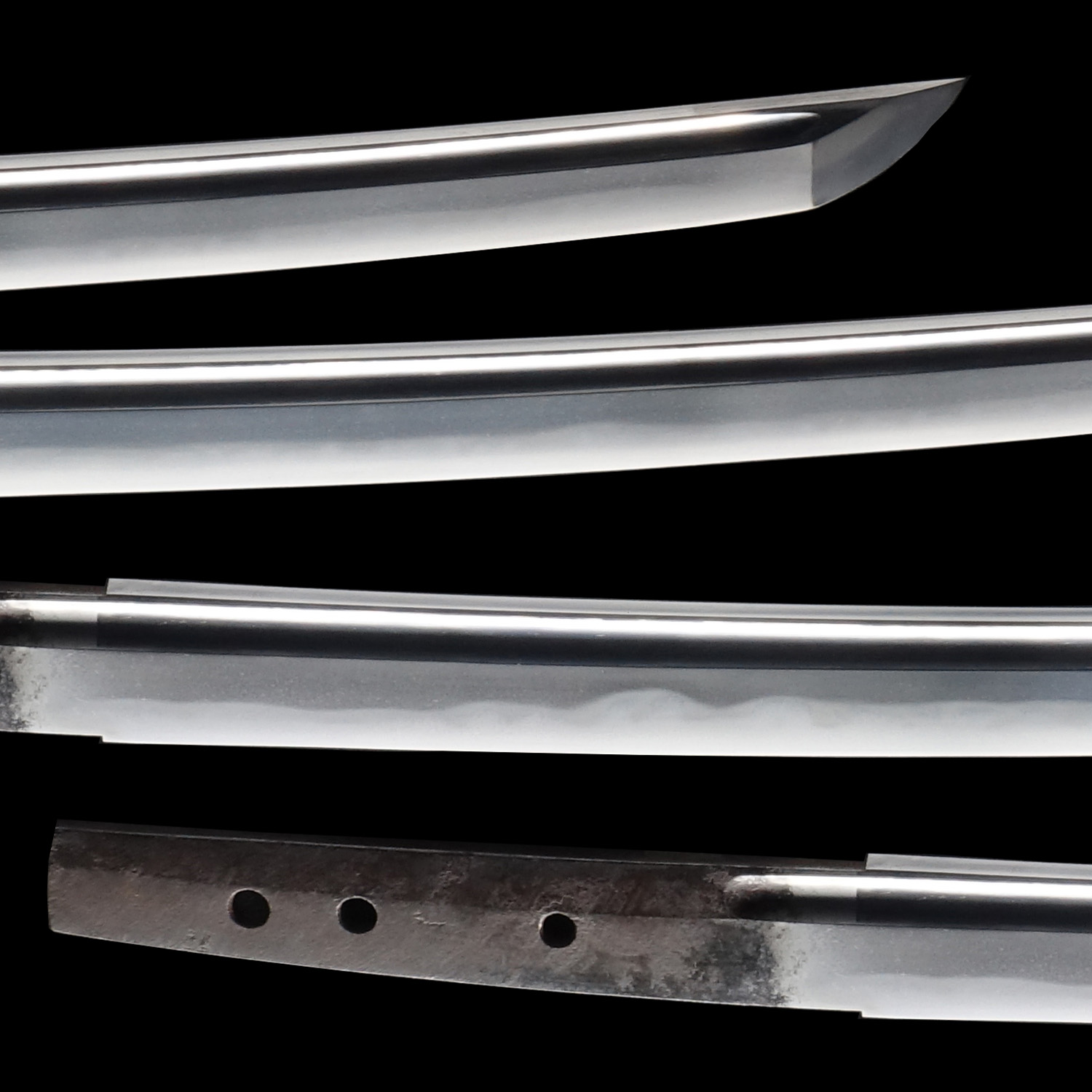
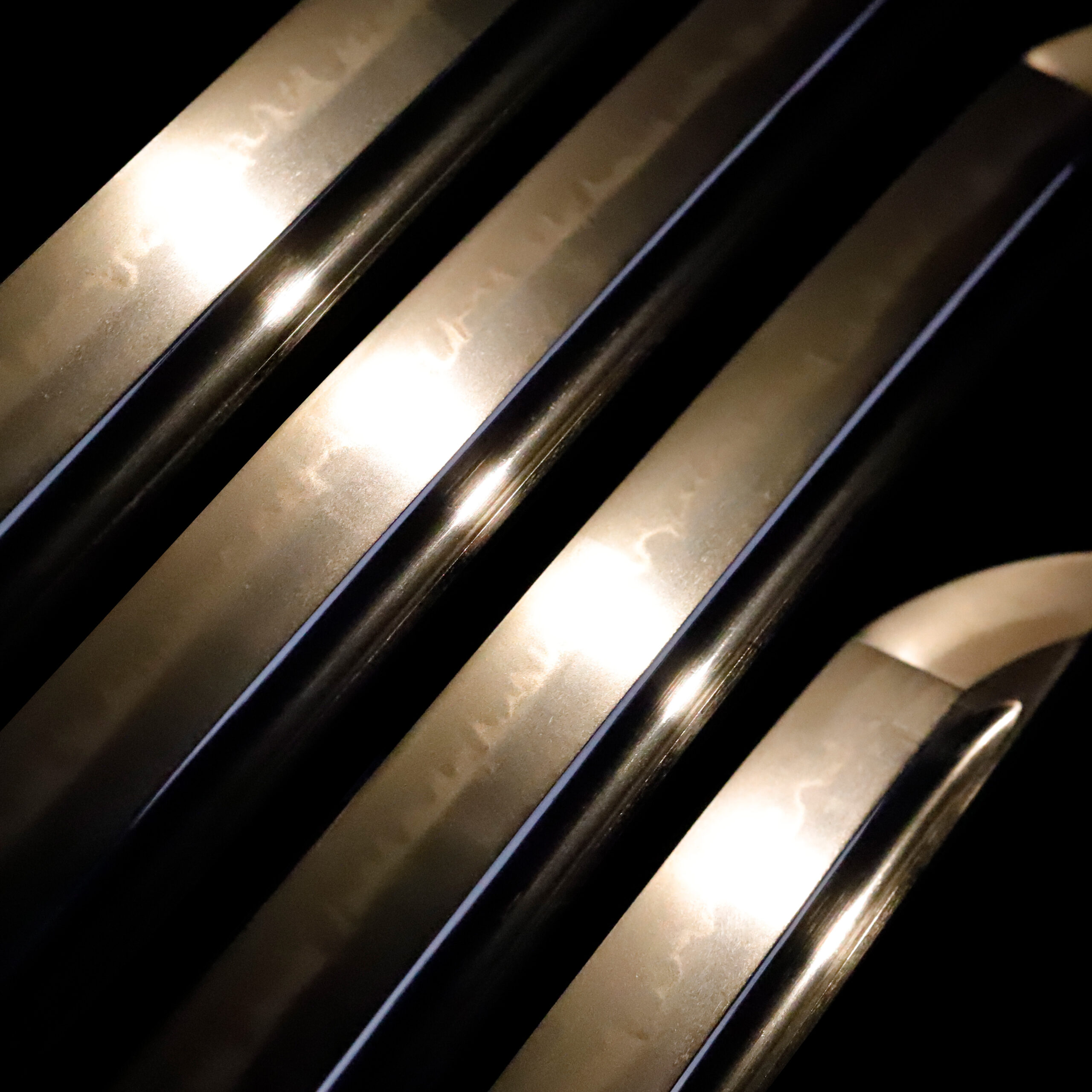
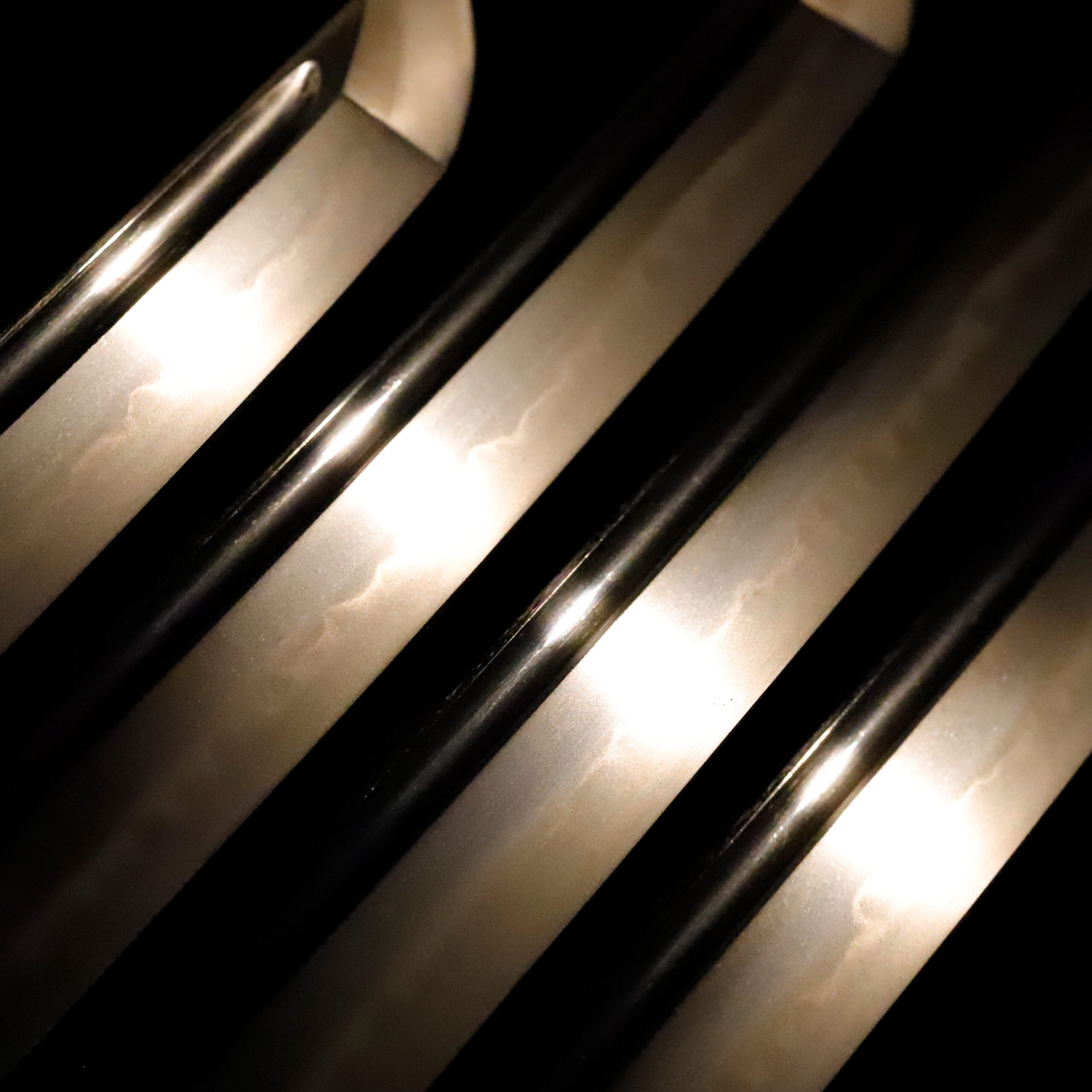
Nakago:Nakago is the tang of the Japanese sword.
Japanese swordsmiths left the black rust on the tang because it prevents red rust while the tang is in its handle. And the discoloration of the tang was created over time, and it is a great indicator for a Japanese sword specialist to estimate when the sword was forged.
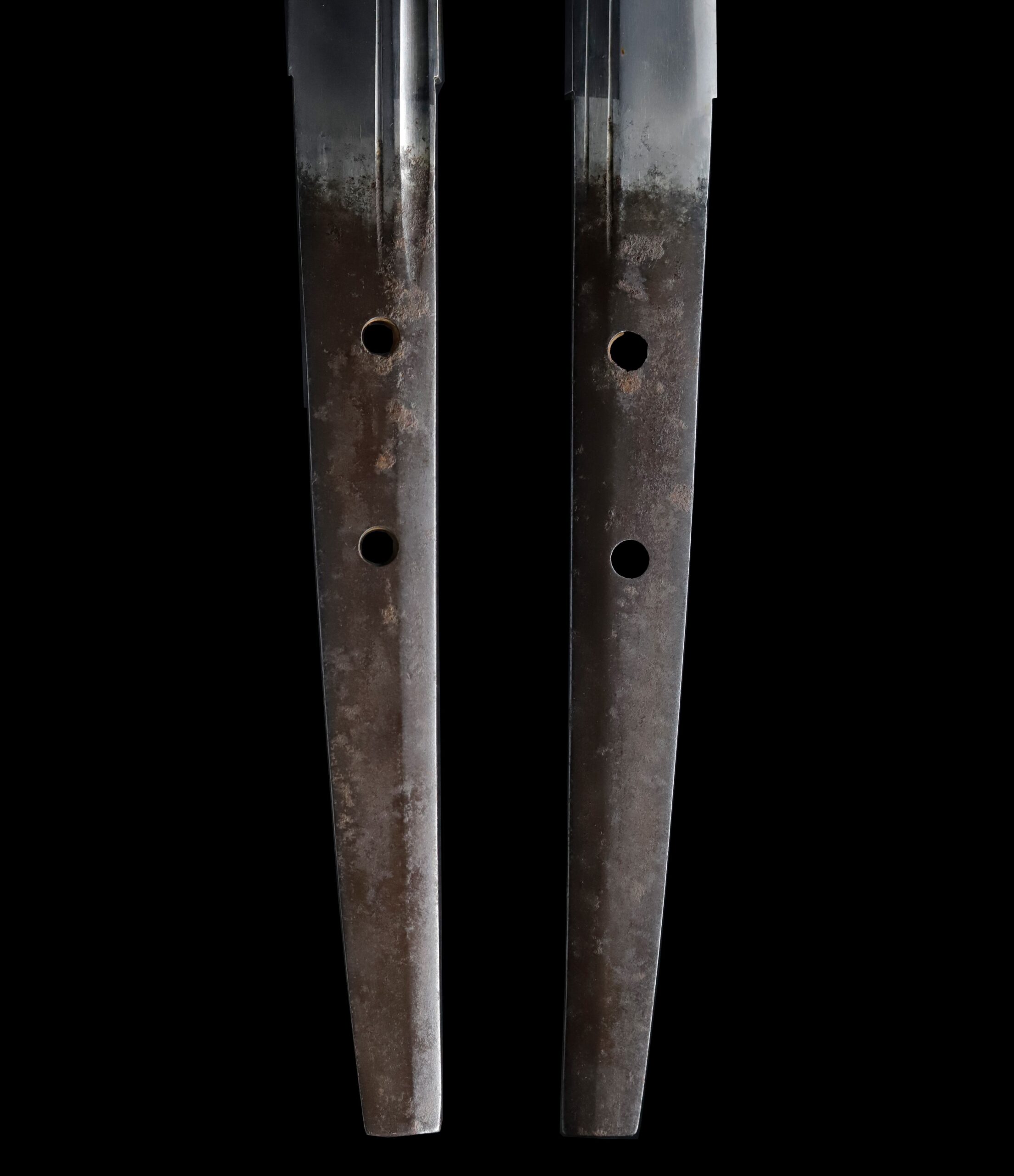
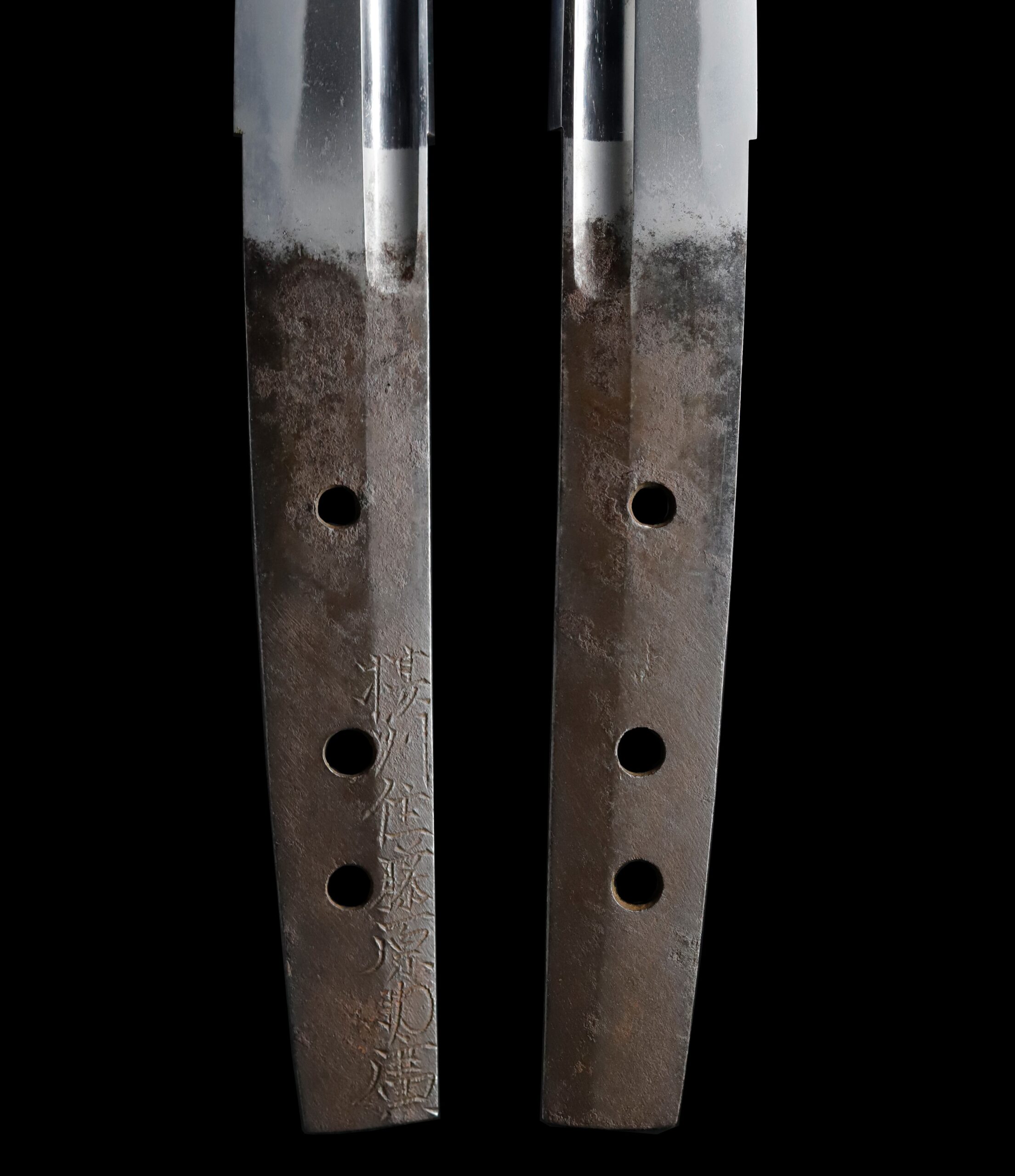
Koshirae: Koshirae is the mounting of the Japanese sword. There are several parts that consist of Koshirae such as Saya(Sabbard), Tsuka( Handle), Tsuba(Handguard).
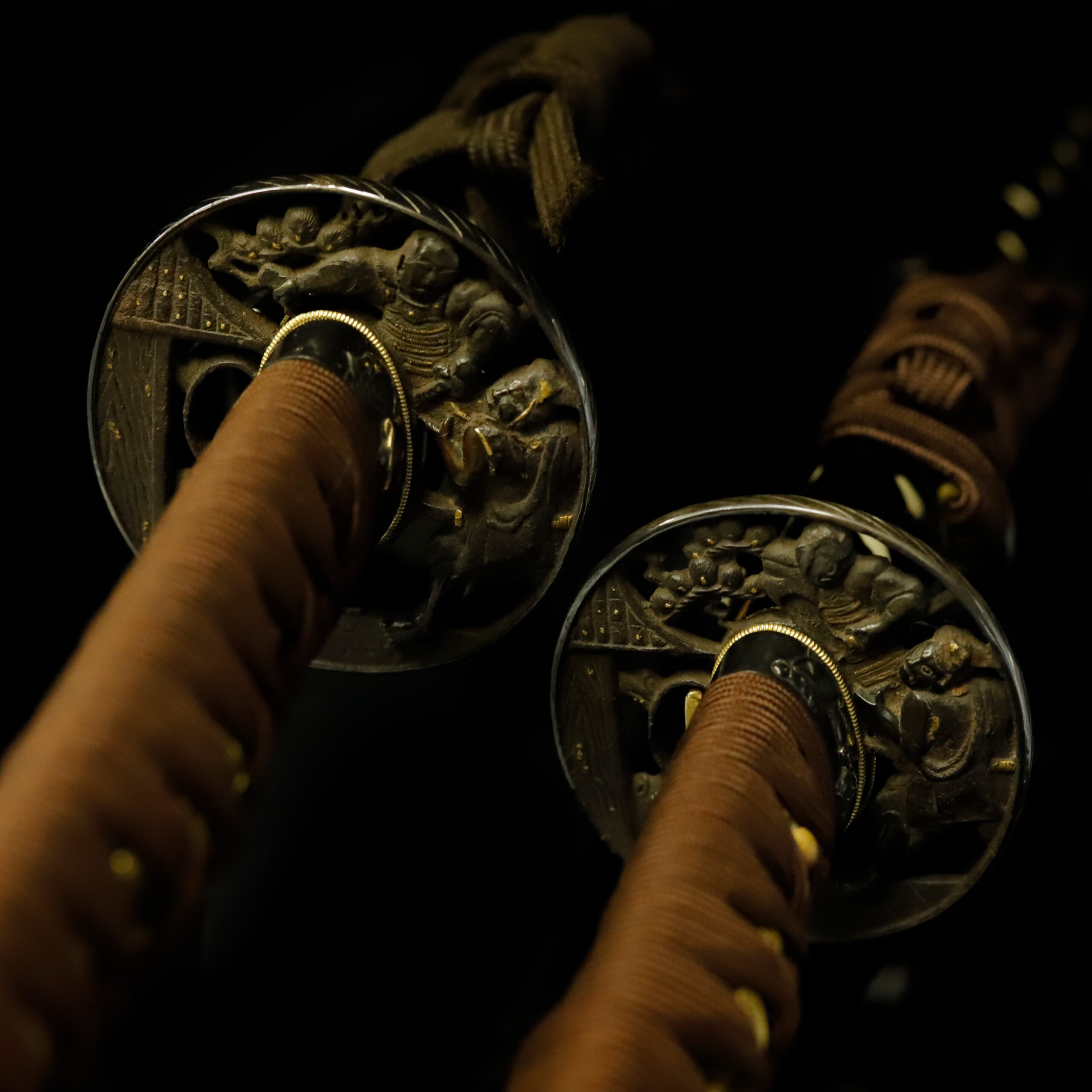
Fuchi-Kashira:A pair of matching sword fittings that cover the upper and bottom parts of its sword hilt.
Both Fuchi Kashiras have the same design. These Fuchi Kashiras are highly decorative sword mountings thanks to gold, silver, and copper coloring applied everywhere.
You would find the figures of men on the Kashira parts and horses on the Fuchi part. The style of their clothes looks continental. One of them is probably a warrior, and the other seems to be a civilian. They are having a meeting or something. We assume they might be consulting for battle.

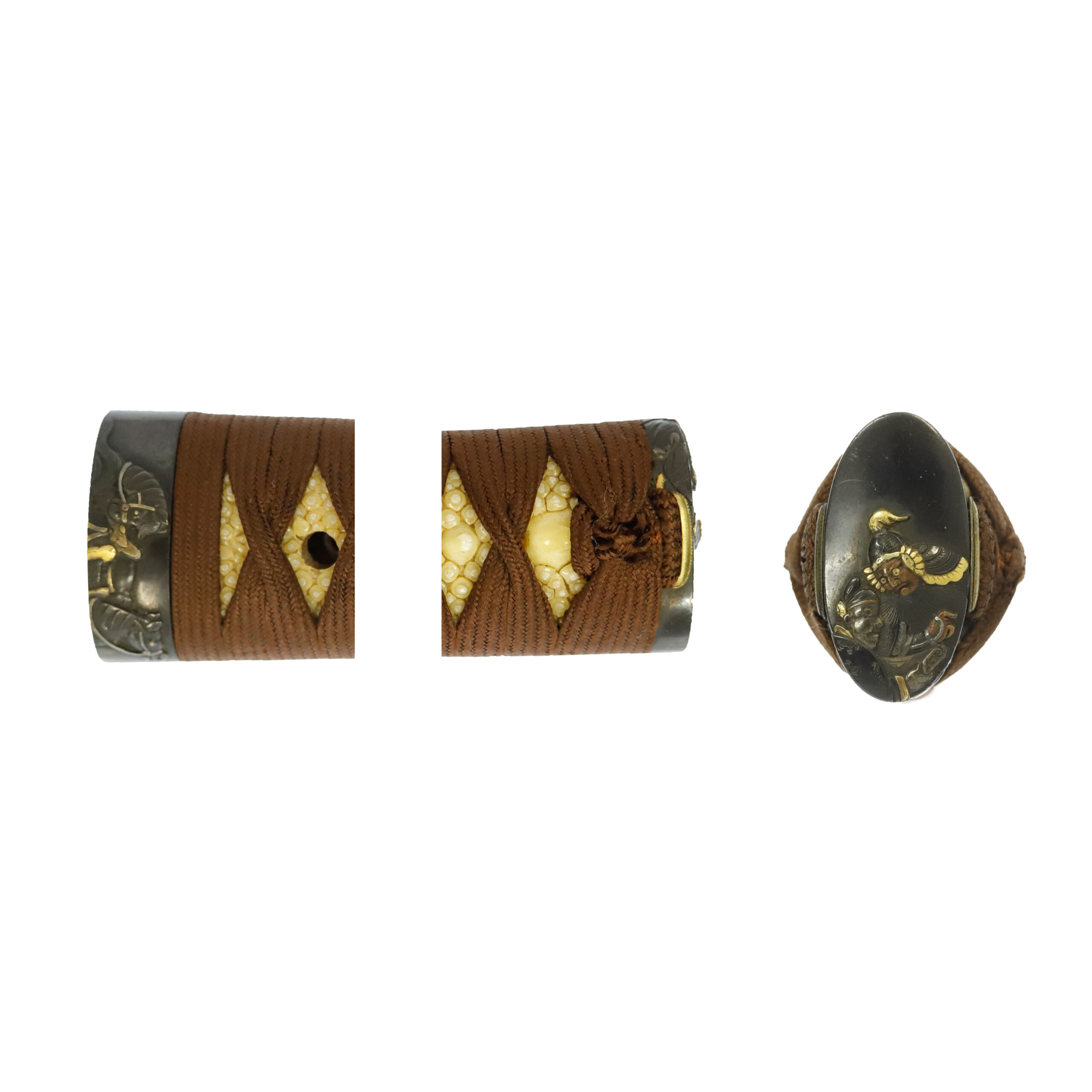
Tsuka and Menuki:Tsuka is the handle of the Japanese sword and Menuki is its decoration.
Each Menuki has different motifs. For the Katana, its design is a combination of two birds. Seeing their figures, we estimate these birds might be cranes or wild geese.
On the other hand, the Menuki of Wakizashi is composed of dragon designs. Both Menukis are all colored with golden paint. Its bright color is applied to each motif and makes them look more decorative. Initially, the dragon was an imaginary creature found in ancient foreign traditions or myths. Furthermore, it is regarded as a symbol of auspicious signs. Its body is likened to nine animals: antlers are deer, the head is a camel, eyes are demons, the neck is a snake, the belly is Mizuchi (蛟, a mythical animal in Japan that looks like a snake and has a horn and four legs), scales are fish, claws are falcons, palms are tigers and ears are cows. It was thought that the dragon would reign at the top of all animals because of its odd-looking appearance. Dragon-designed sword mountings are often seen. It shows that many Samurai warriors favored this sacred beast motif.
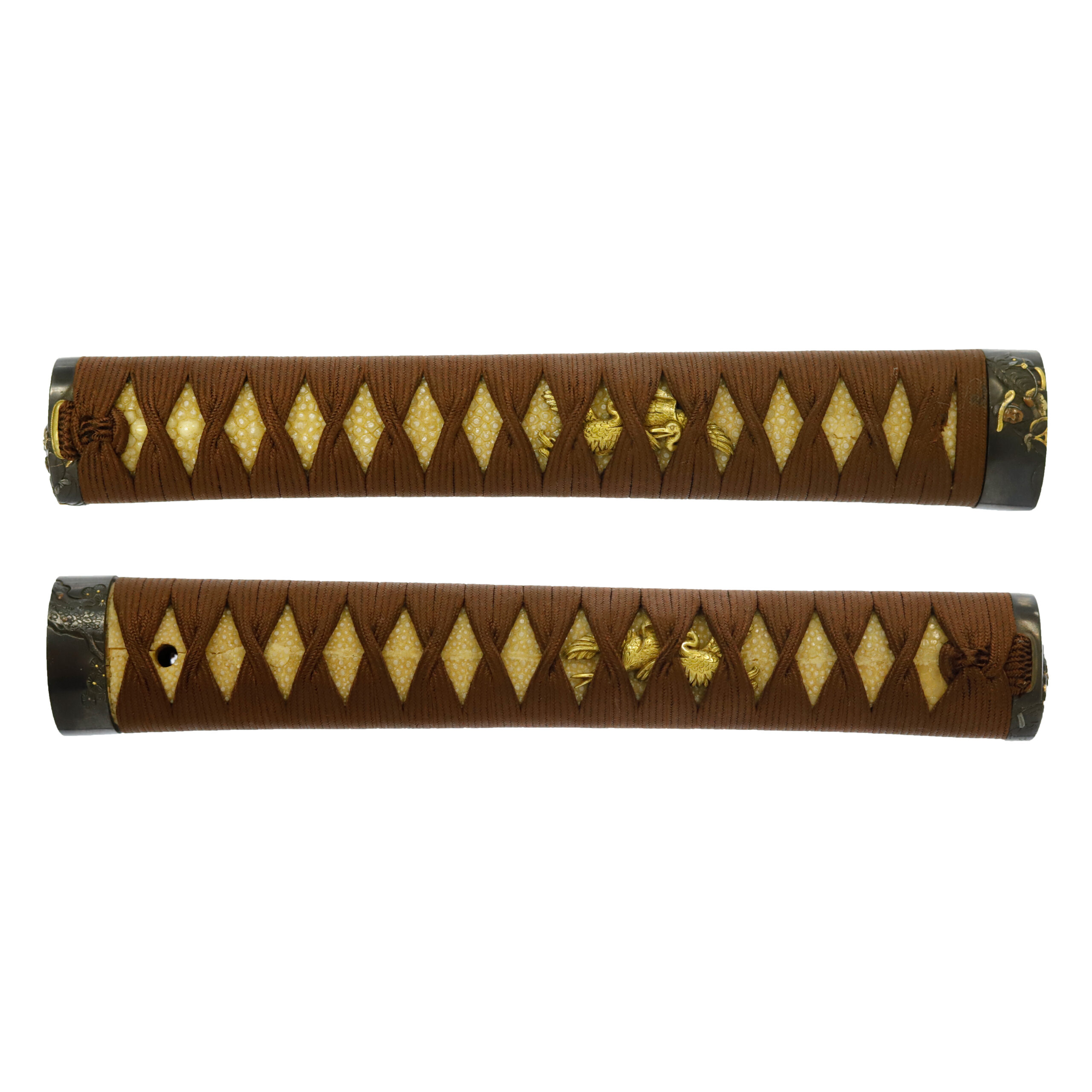
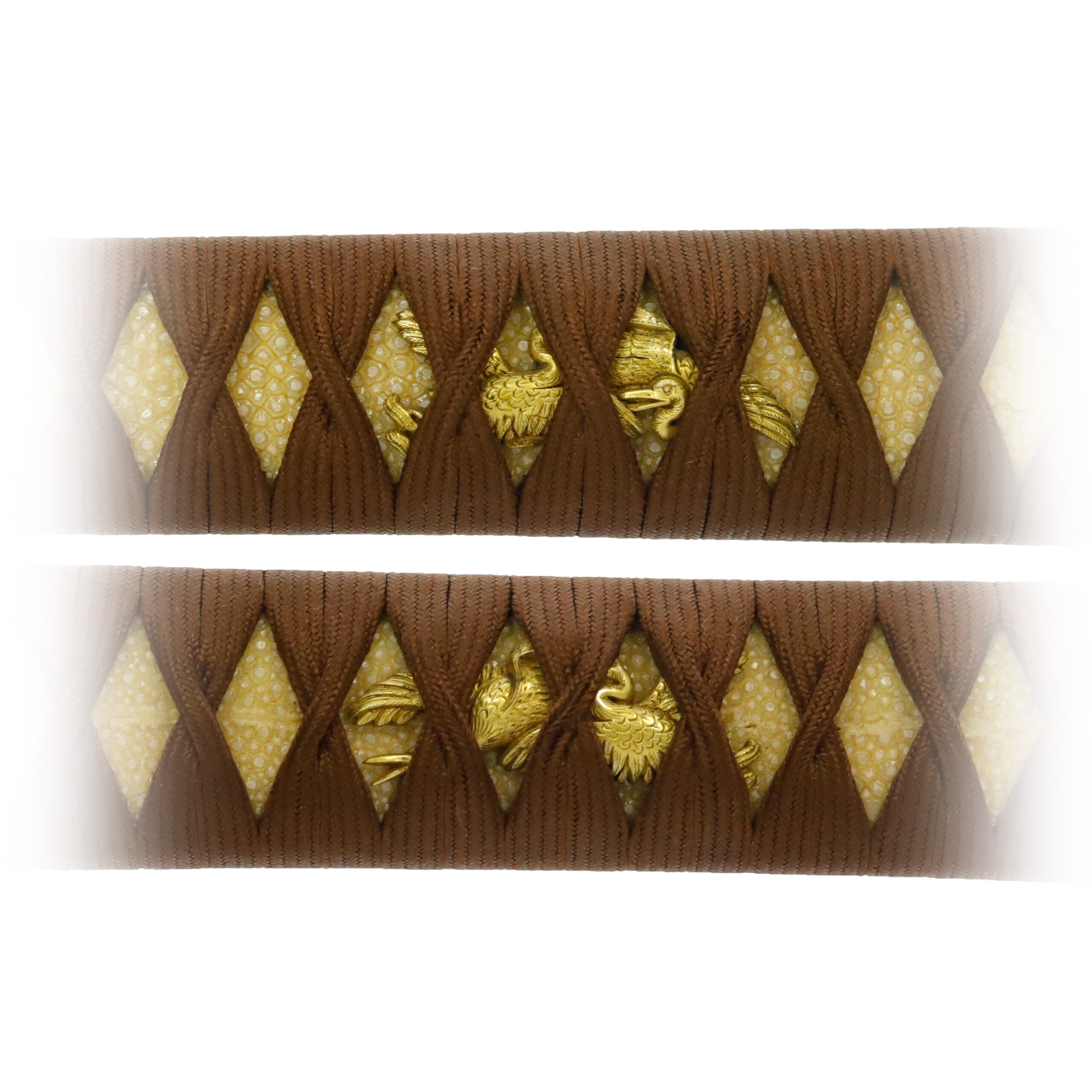
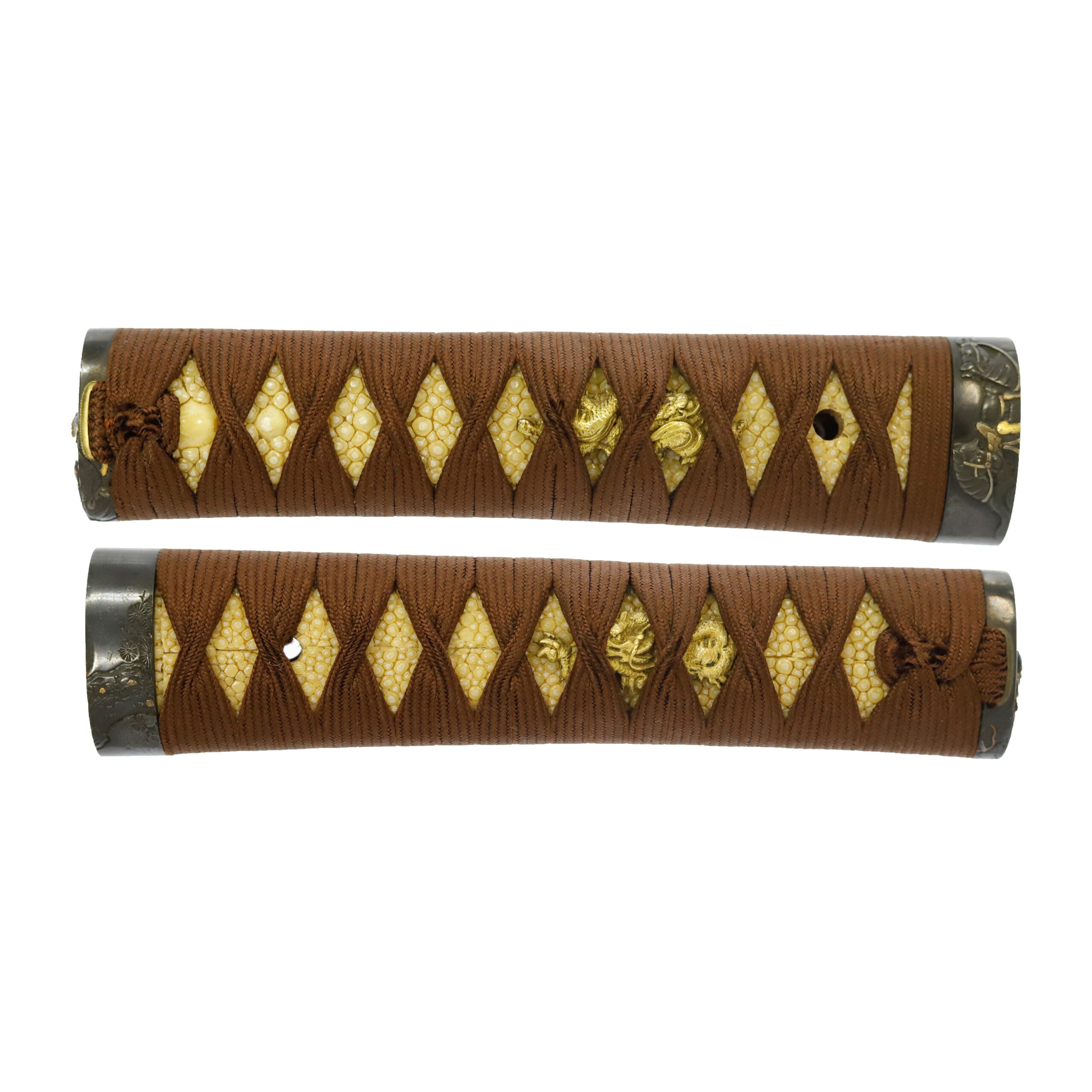
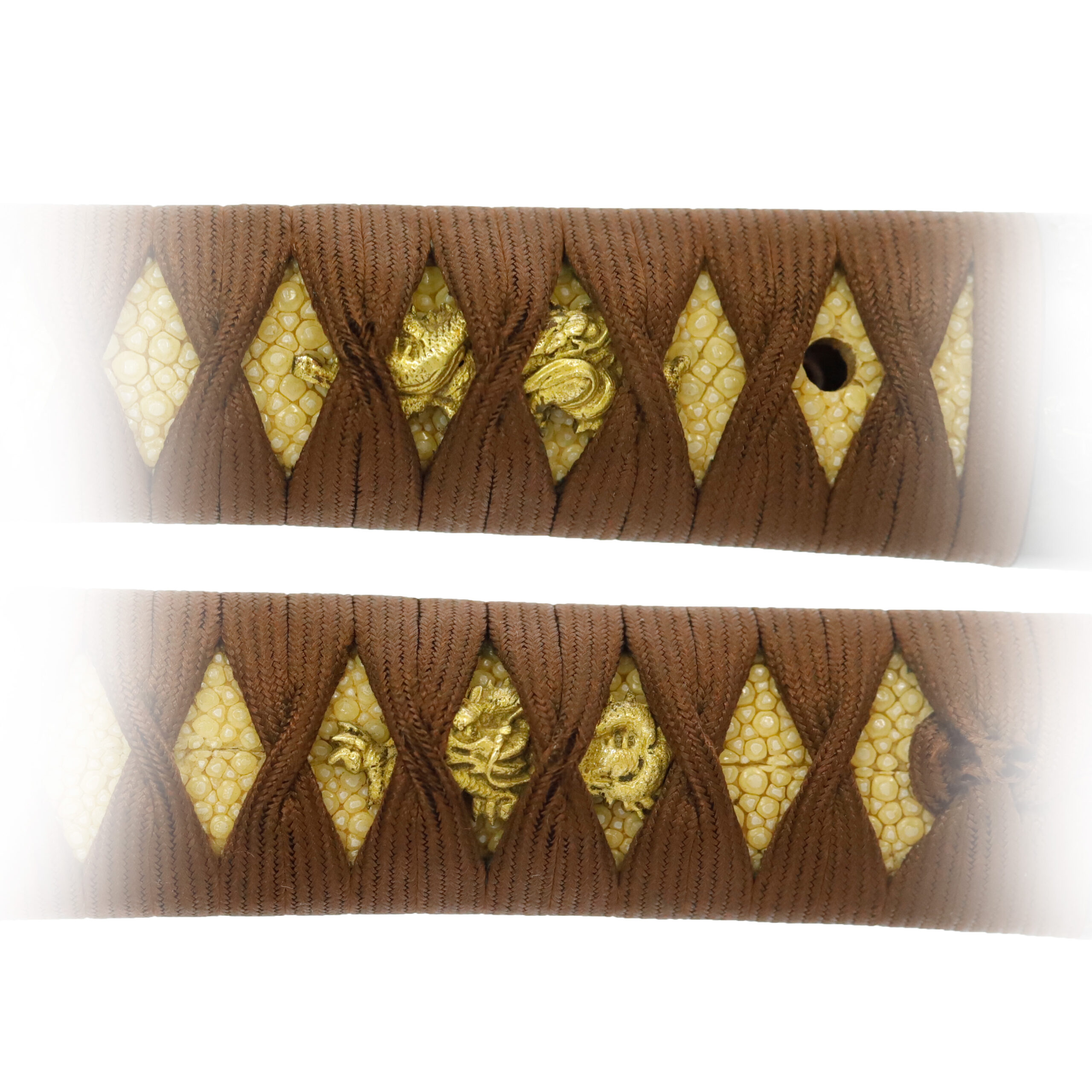
Tsuba and Habaki:Tsuba is the handguard for the Japanese Sword and Habaki is the equipment to make the blade not touch its scabbard inside. It prevents the blade from getting rusty and chipped.
We assume the theme of these Tsubas is related to the Fuchi Kashira mentioned above. In these Tsubas, two men are fighting each other. So, this Tsuba depicts a scenery of a battlefield. We would categorize it as the Kassen Zu (合戦図). It seems two Samurai warriors are the principal characters. They are wearing gorgeous armor, and golden paint is applied to them while some colorings have already faded.
The Kassen Zu is also seen in the Byoubu (屏風, folding screen) works. According to a theory, Kassen Zu designed folding screens that were made after the beginning of the Edo period. Therefore, many of them did not necessarily depict reality as it was. For that reason, we often find inconsistencies in Kassen Zu Byoubu based on historical research. The Kassen Zu was more concerned with showing authority than historical accuracy, and political intentions were involved.
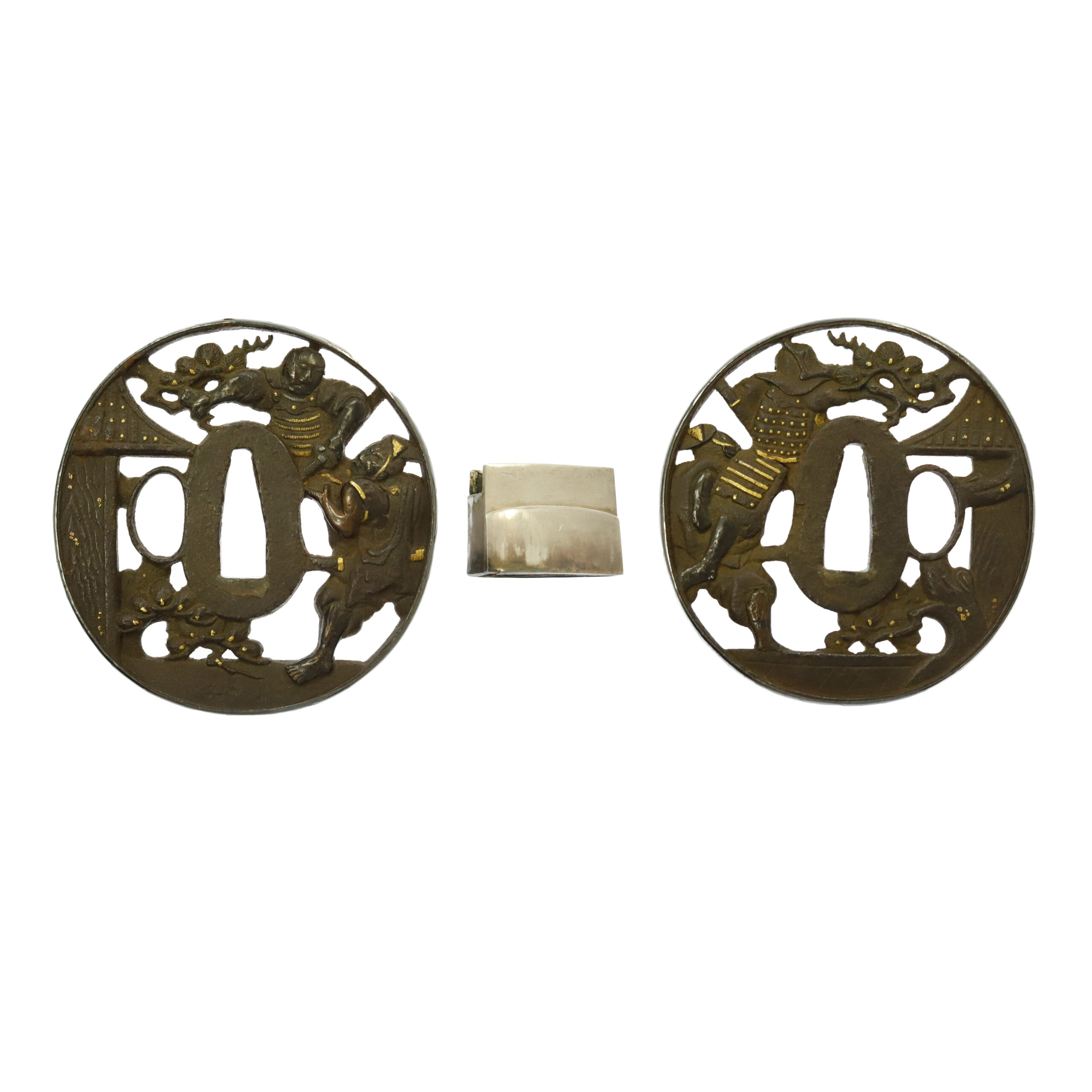
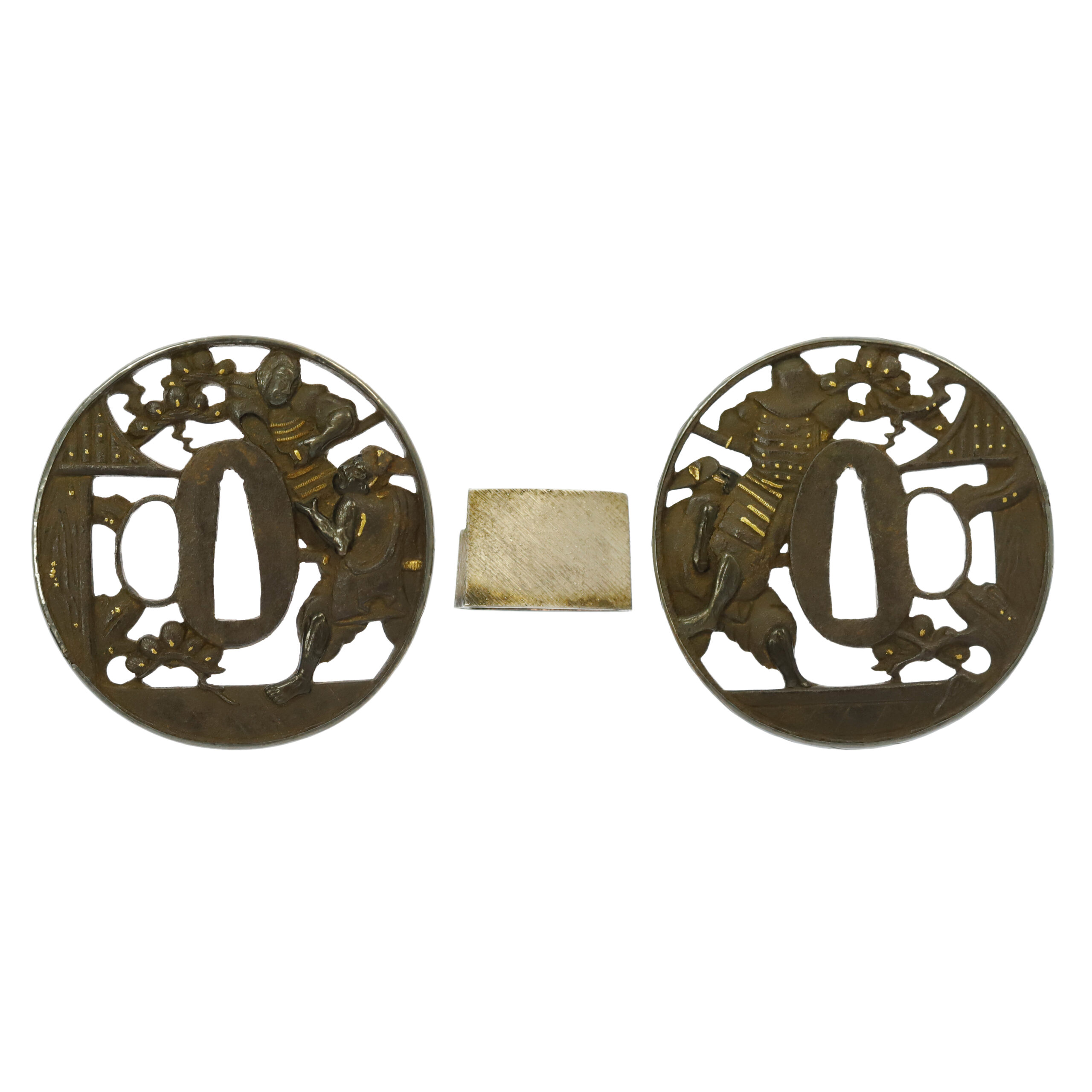
Saya: Saya is the scabbard for the Japanese sword.
*Please keep in mind that some lacquers on these Sayas are partially cracked due to their age.
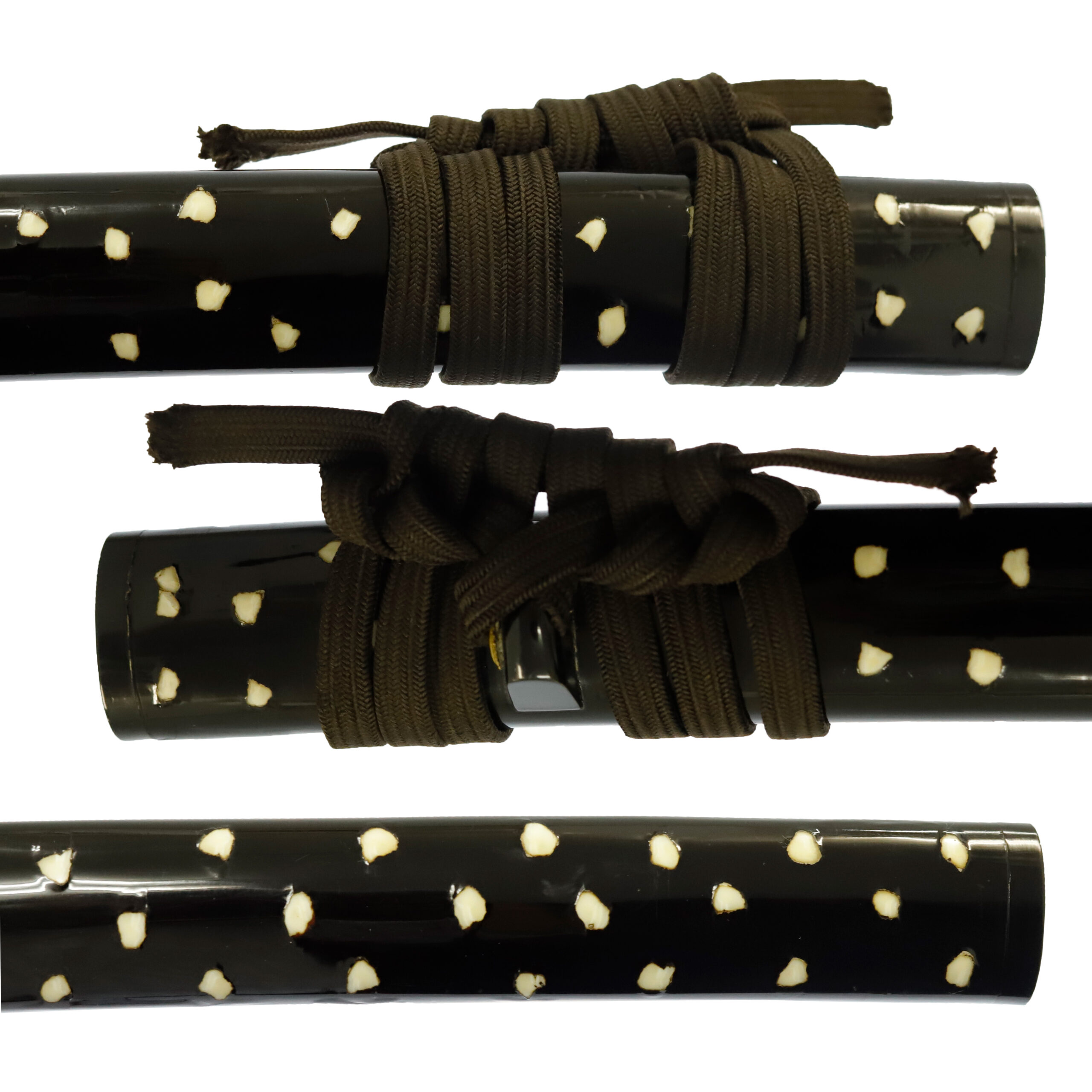
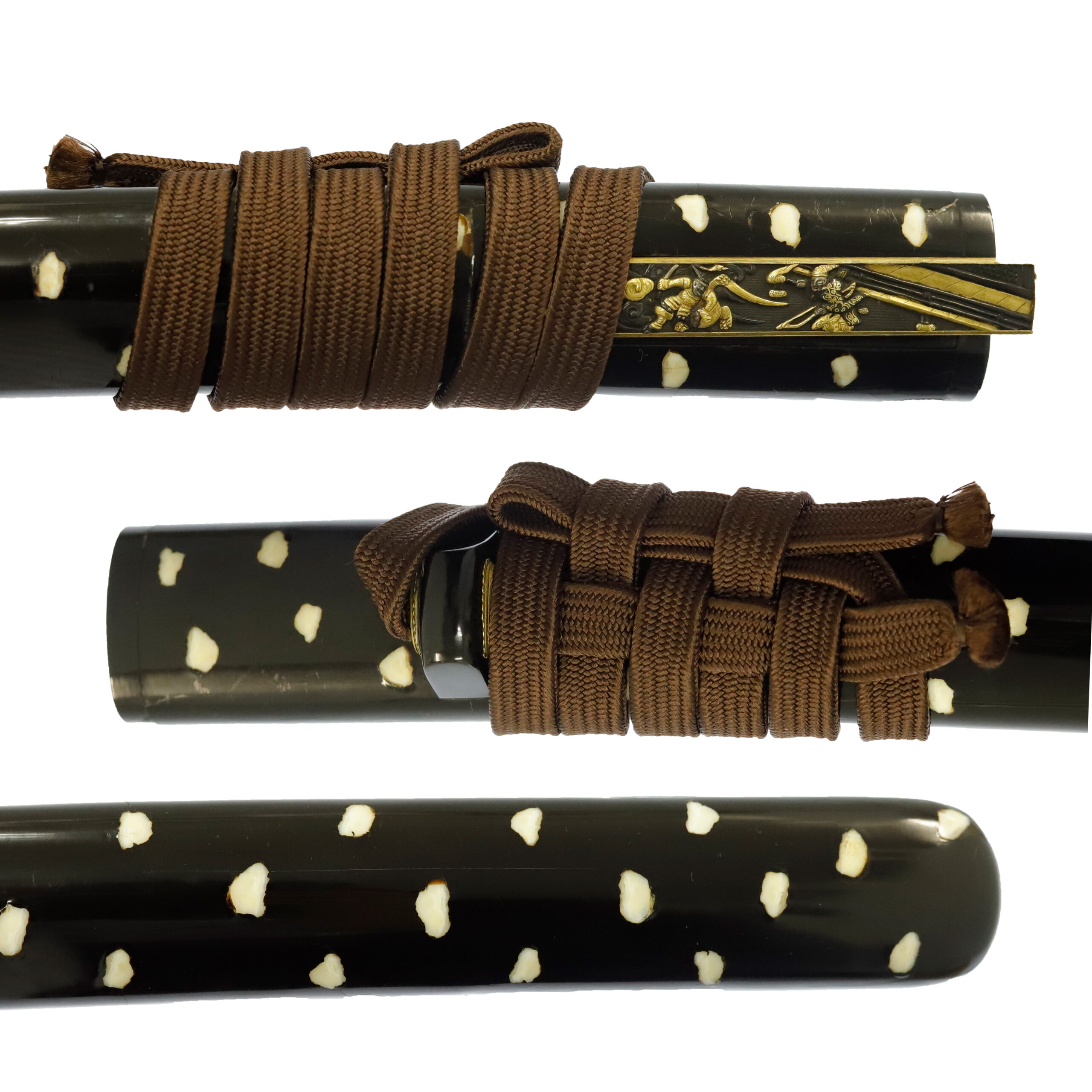
Kozuka:Kozuka is a small knife stored in Kozuka Hitsu (groove of the sheath of the Japanese sword).
A Kogatana (小刀, small knife) is stored in the Kozuka. The surface of this Kozuka is decorated with the Nanako-Ji (魚子地) technique. This process makes a uniform minimal protrusions pattern by hitting the Nanako-Ji Tagane (魚子地鏨, a chisel for this technique) on a metal surface. This decorative technique is often seen on sword mountings.
This Kozuka’s design is also related to Samurai, the same as the Fuxhi Kashiras and Tsubas of this Daisho Koshirae. A man with something like a bird’s wing sprouting from his back seems to run away, while another man with a bow in his hand seems to be chasing him. Whether it is a battle between Samurai or a one-sided extermination, the details are not clear. However, the screen is made to be full of dynamism.
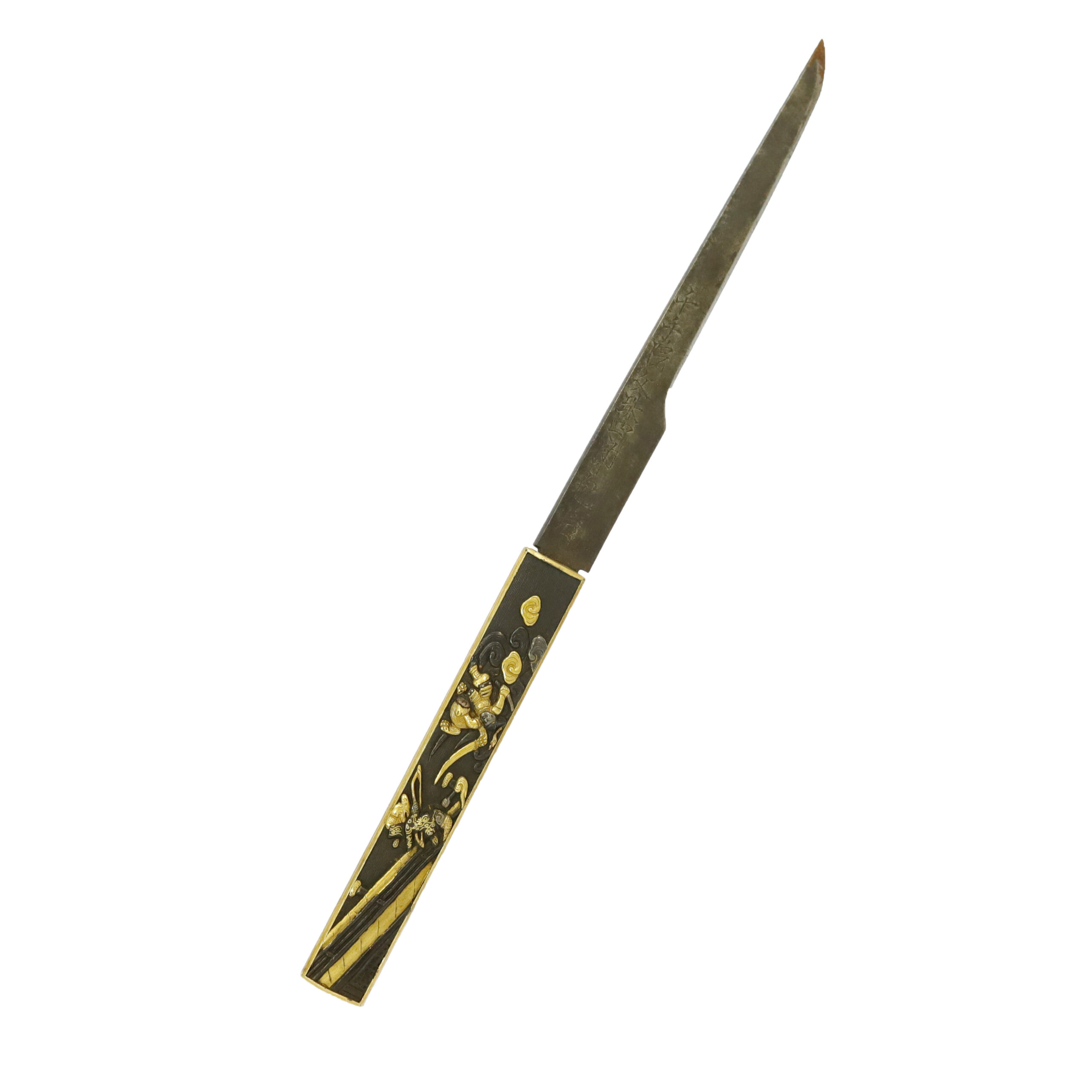
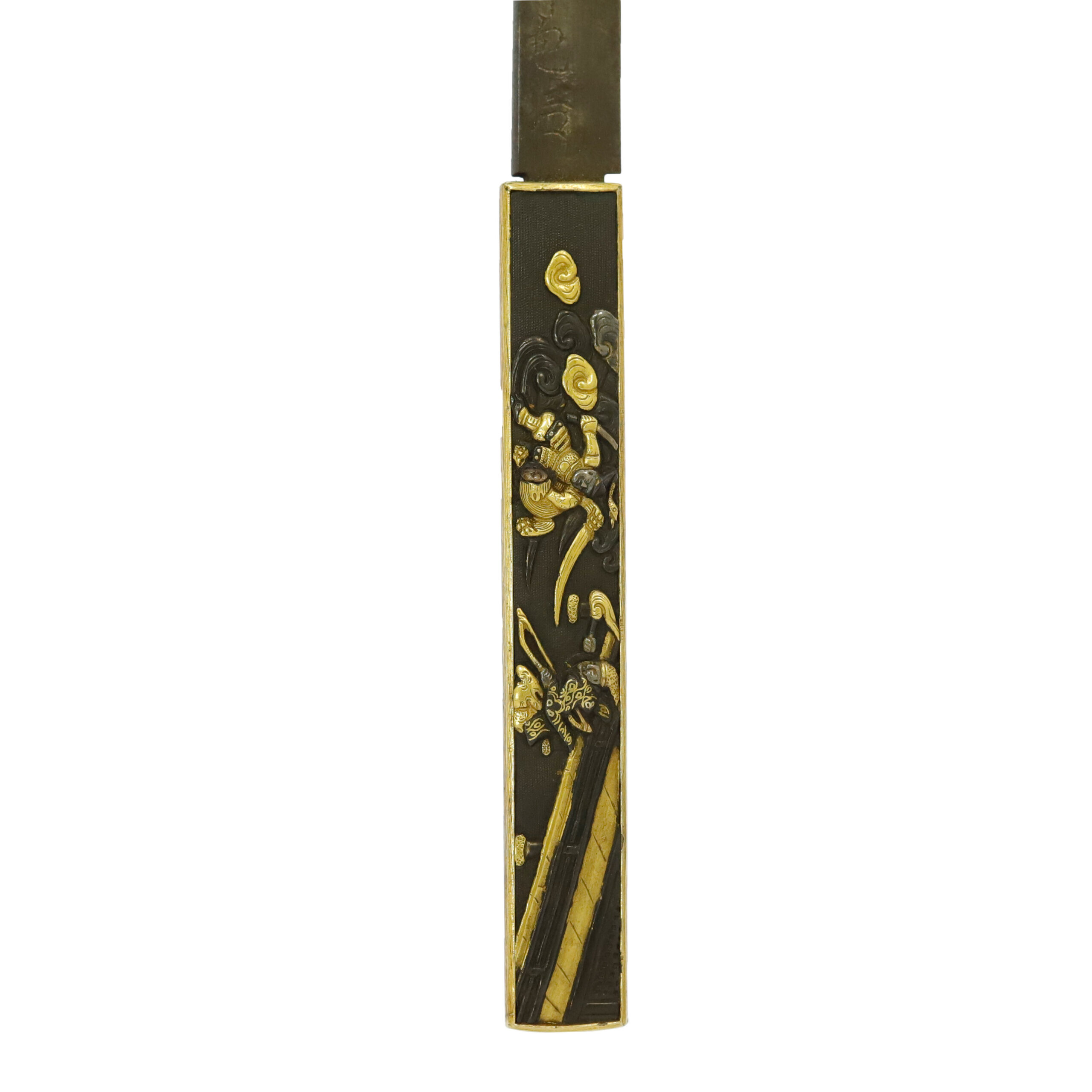
Authentication Paper:NBTHK Hozon Certificate for the Katana (No. 3029460) & Tokubetsu Hozon Certificate Wakizashi blade (No. 1018632)
NBTHK, also known as Nihon Bijutsu Touken Hozon Kyokai (the Society for the Preservation of the Japan Art Sword), is one of the oldest Japanese sword appraising organizations in modern-day Japan. They authenticated these two blades on August 25th in the 4th year of Reiwa (2022). They appraised Katana as a Hozon Touken and Wakizashi as a Tokubetsu Hozon Token, the blade worth preserving for Japanese society. The purchaser will receive these original certificates as well. We can also translate what is written into English and make a PDF file for your record if you request.
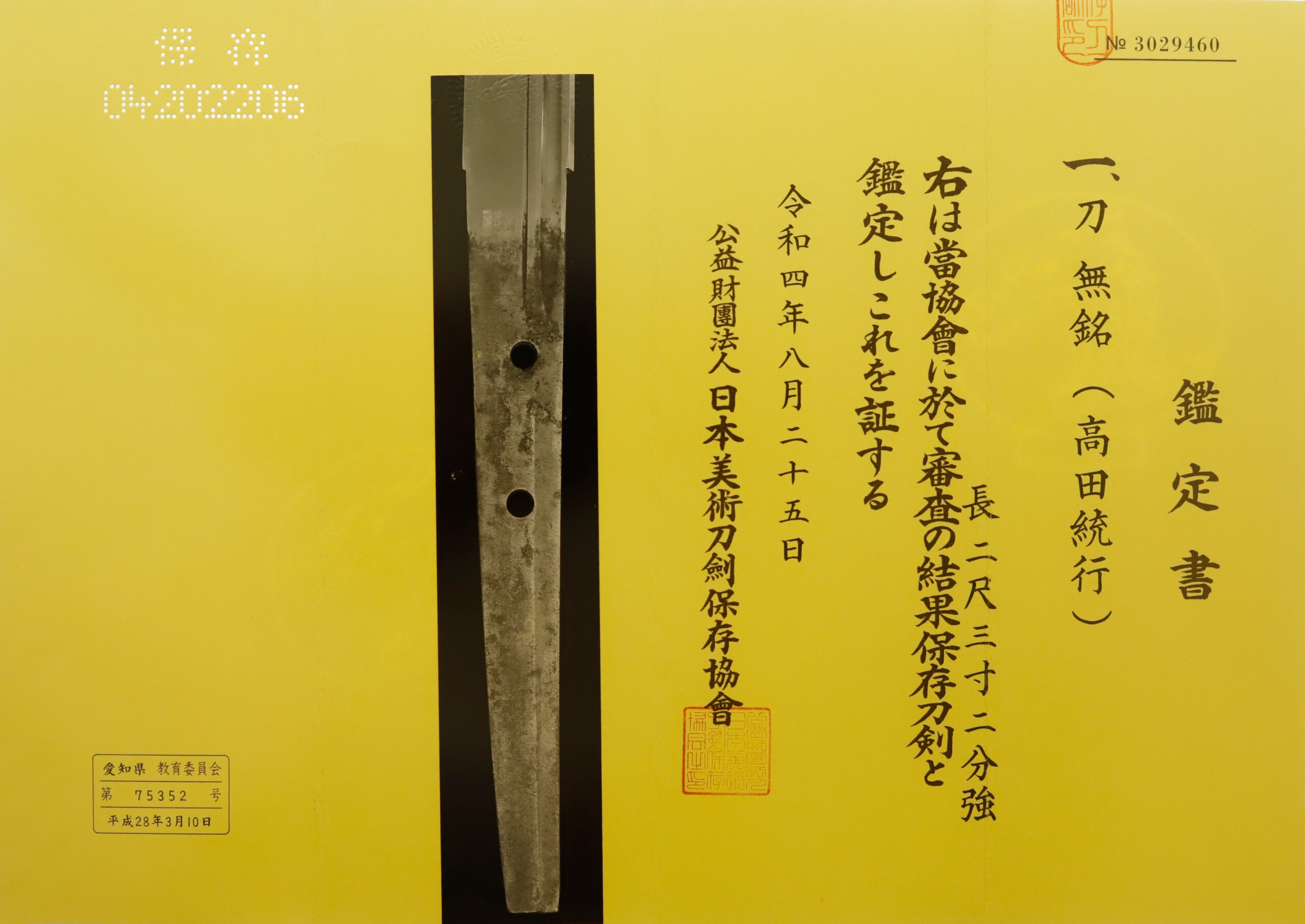
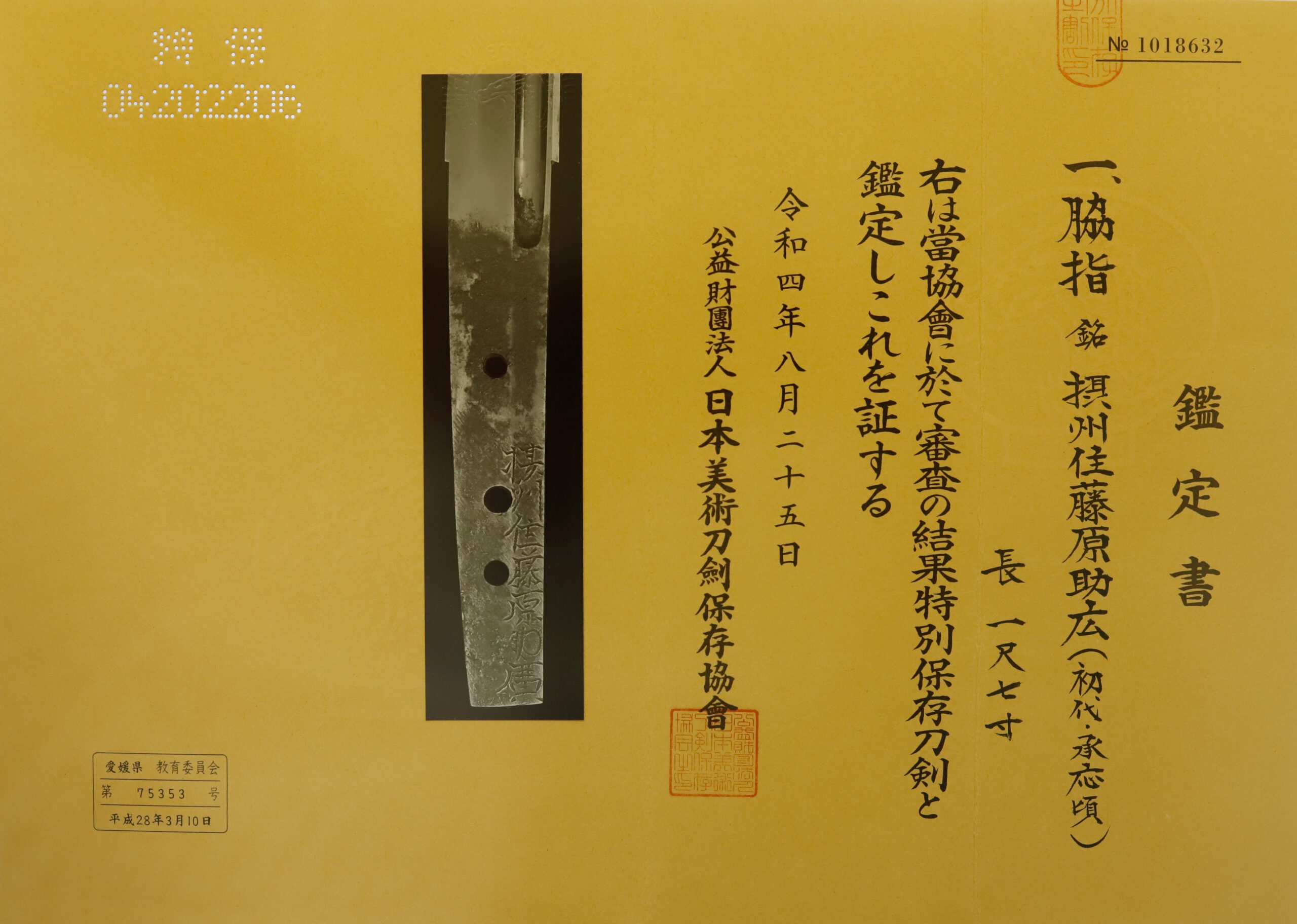
Registration Number : Aichi 75352-75353
The Board of Education in Aichi prefecture issued a registration paper for this Katana blade and Wakizashi blade . It is called Jyu Token Rui Torokusho(銃刀剣類登録証). Bunkacho(The Agency for Cultural Affairs) acknowledges a Japanese sword with this paper as a work of art.
The sword needs to be traditionally hand-forged and made of Tamahagane carbon steel to be registered in the system. With this paper, its owner in Japan can legally own an authentic Japanese sword. Based on this registration number, we will apply for its export permit.
This paper will need to be returned to the board of education when the sword is being shipped abroad, but you can receive a copy of it. An English translation of this registration paper is available on request.
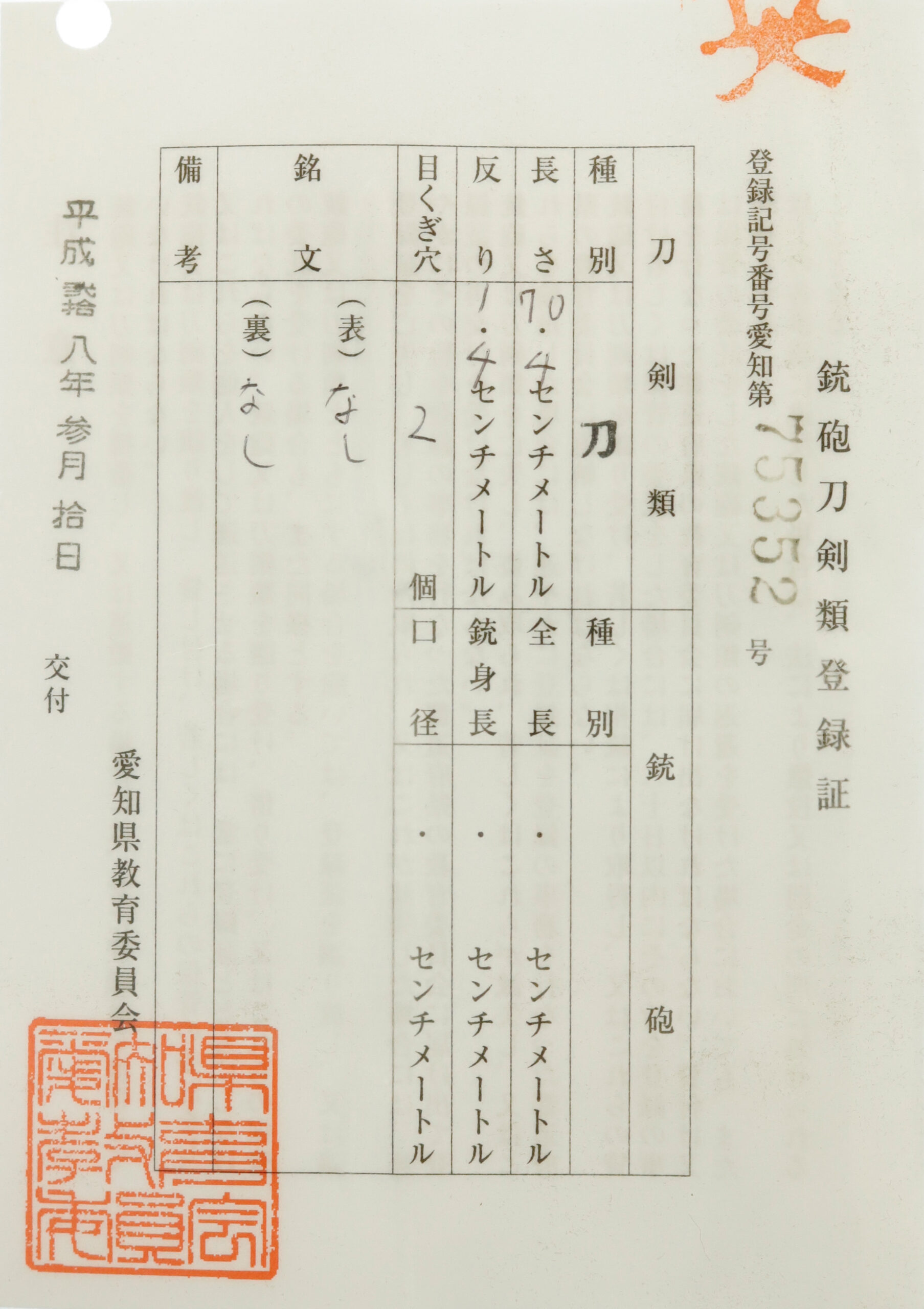
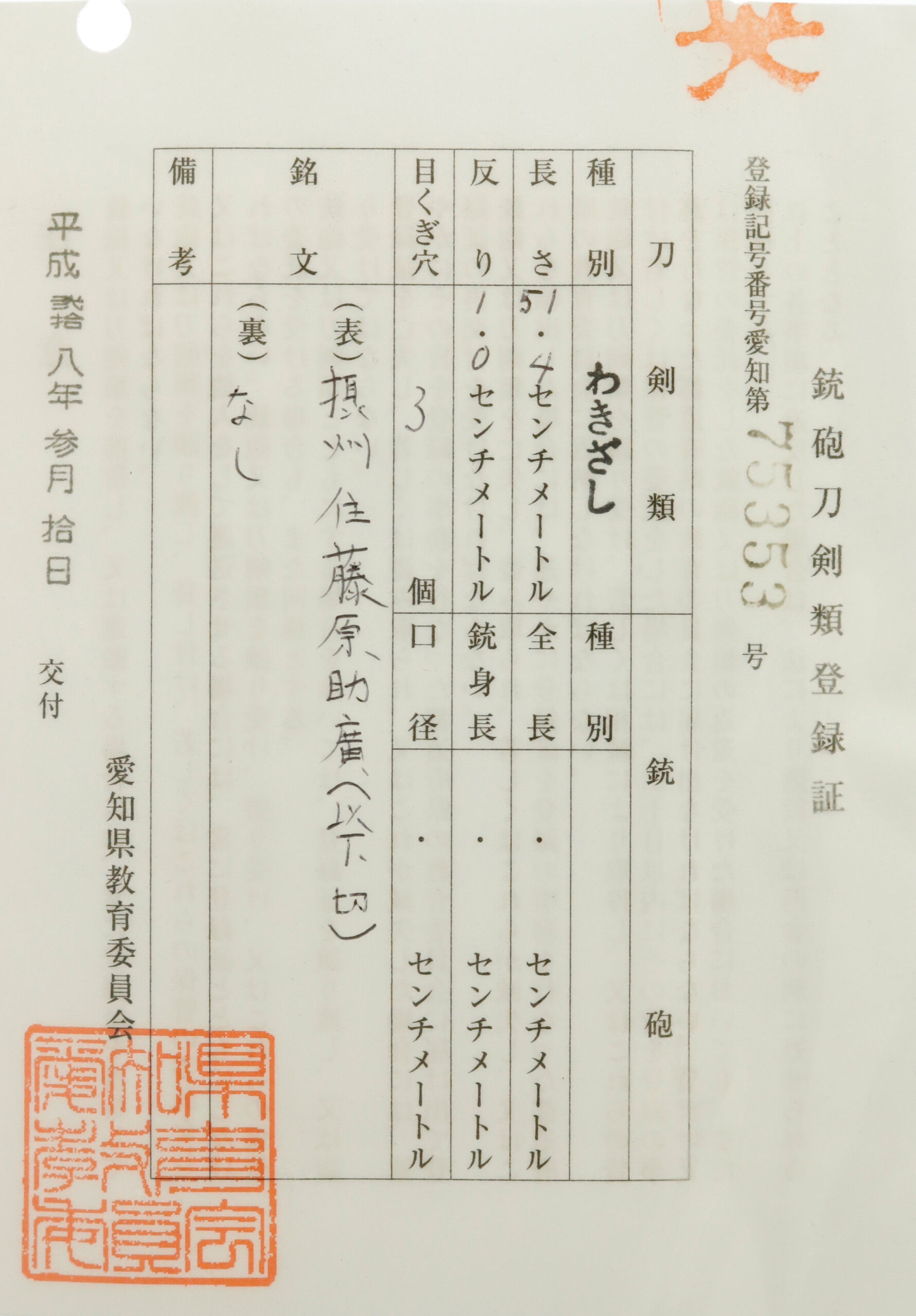
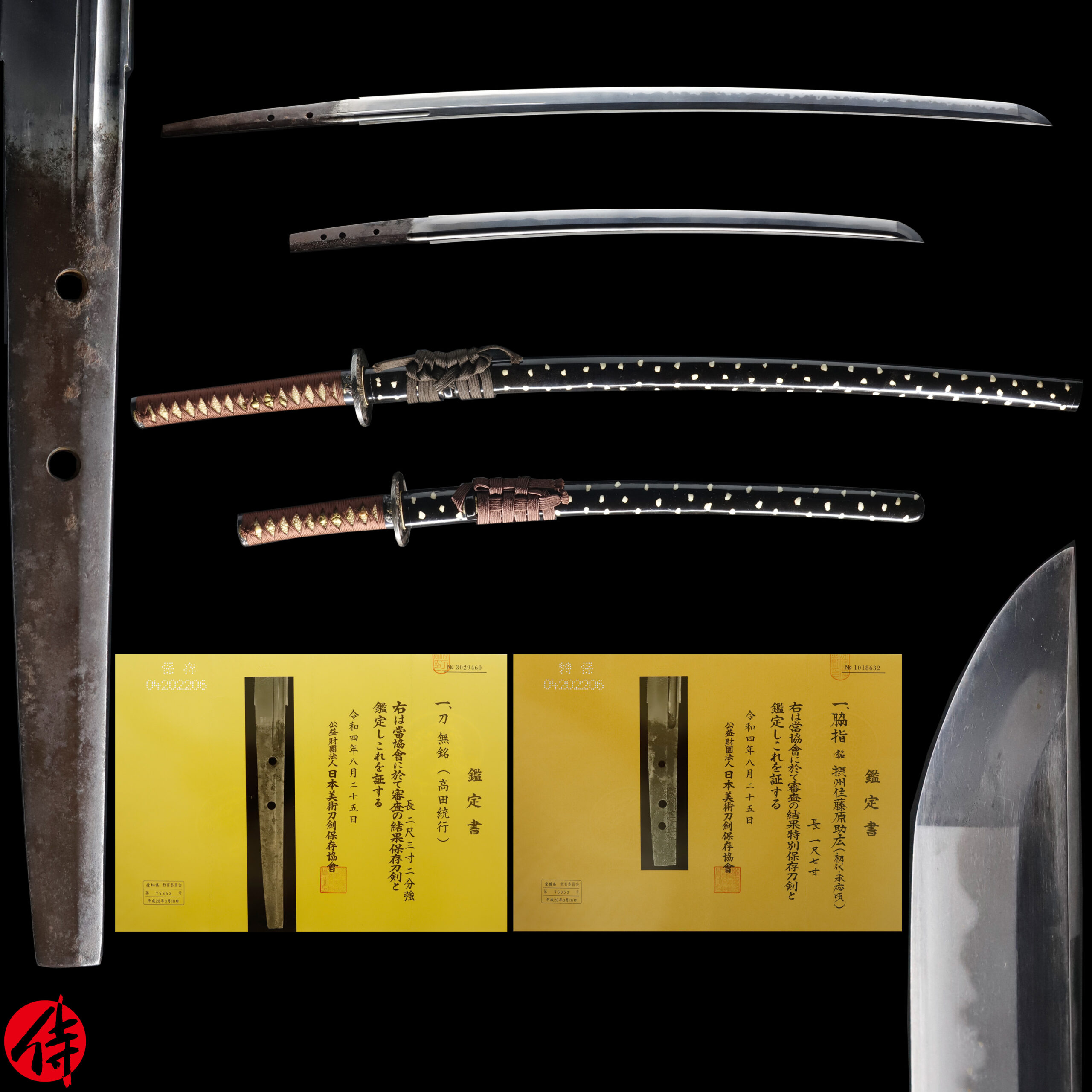
—————————————————————–
【About us】
Samurai Museum is located in Tokyo, Japan, exhibiting antique artifacts related to the Samurai history. Samurai Museum Shop is the place for those who are interested in Japanese culture and craftsmanship. We deal with antique Samurai swords/armor, traditional crafts made in Japan and so on.
【Japanese Sword& Export Process】
The Japanese swords we deal with are hand-forged edged swords made in Japan. It was made from the traditional carbon steel called TAMAHAGANE(玉鋼). Samurai Museum is familiar with the proper legal procedure for an antique/ authentic Japanese sword to be exported from Japan. We have sent more than 500 Japanese swords for the past three years (~2023) to amazing owners who appreciate its historical value.
Each Japanese sword is registered under the Agency for Cultural Affairs and the Board of Education in Japan. They issue a registration paper for each Japanese sword for its owner in Japan to legally possess it. The Japanese sword with its registration paper means it was traditionally hand-forged in Japan.
To legally export the sword from Japan to other countries, we will have to apply for its permit to the Agency for Cultural Affairs(Bunkacho) and return the original registration paper to the Board of Education. It normally takes around 2-4 weeks to receive this permit after submitting required documents. And we would like you to expect at least 1-1.5 months for your order to arrive at your given address after you ordered. For more detailed info, please click here.
It is allowed for residents in Japan to own authentic Japanese swords without a special license as long as they come with registration papers. Please feel free to contact us if you are a resident of Japan, whether temporarily or permanently. We will also assist you when you leave Japan and need to obtain the export permit.
【Payment Method】
We accept payment through Stripe (Credit card), PayPal, Apple Pay or ChromePay, all of which are secure payment methods. Also, you don’t need to make an account on Stripe for the checkout. If you prefer other payment method, please contact us. After confirming your payment, we will apply for an export permit. You may either pay in JPY, USD, AUD, CAD,EUR CHF or GBP. The price is set in Japanese Yen. Prices in other currencies are automatically calculated based on the latest exchange rate.

* If the amount is above 1 million JPY, Stripe or wire transfer will be the only options for payment.
【Shipping】
We have shipped authentic Japanese swords to the USA, UK, Canada, Mexico, Germany, France, Hong Kong and Australia. If you don’t live in these countries and like to order, please contact us first before making a purchase. We offer Free International Shipping as long as we can send antique Japanese swords by EMS.
We normally ship by EMS(Express Mail Service) provided by Japan Post. We will send you a tracking number for your order as soon as we hand it to the post office. We will put 100 % insurance on the shipping document without any extra charge. Based on the total amount, there might be a duty tax or other fee for you to pay, depending on the countries. We use package cushioning to protect the item and put it in a PVC pipe, which is one of the most secure packages because of its durability.
It will normally takes 5-14 days for the item to arrive at your given address after we dispatch it. Time of delivery is estimated as accurately as possible by the carrier but does not take into account any delays beyond our control such as by inclement weather, post office holiday seasons.
* If you live in Australia and like to purchase an authentic Japanese sword, please click here to know the detail.
*Please keep in mind that due to the spread of COVID-19, there might be delays in shipping. If you like to know the detail about shipping, please feel free to ask us.

【Review】
Here is one of the reviews we received from a customer who purchased an authentic Japanese sword from us. For more reviews, please click here.
“My experience overall with the whole process was wonderful. I had many questions about the history and process to purchase these treasures. All my questions were answered very timely and complete. The staff is very knowledgeable and very well versed if any questions do arise.”
【How to make sure the condition】
Please keep in mind that what you are going to purchase is an antique item. We uploaded high resolution photos for you to check its condition thoroughly. If you like to see more photos with different angles, please feel free to contact us. We will be happy to send them to you so that you can make informed decision. It is essential for us to know that you are happy with your choice of a sword. and we are prepared to use the best of our ability to serve you.
【How To Contact Us】
Please contact us through email, Facebook Messenger or Live Chat if you have any questions. You can find each icon on the right side of the website. Please click one of them to reach us. We will reply to you within 1-2 business days.
【The Art of Nihonto (Japanese Sword)】
Samurai’s history is a profound, eloquent legacy of ancient Japanese warriors in which millions of people worldwide are being fascinated. If you like to find out the art of Nihonto, please click here.
【A Guide to Japanese Sword Maintenance】
After acquiring an genuine Japanese sword, it is also important to know how to take good care of it. Here is the special video for you. Mr. Paul Martin, Japanese sword expert, shows you how to give proper maintenance to your sword. By mastering how to clean the Japanese sword, its aesthetic beauty will last forever.
When you purchase a Japanese sword from us, you can get a Free Japanese sword maintenance kit. It comes with four tools(Choji Oil, Uchiko Whetstone Powder, Peg remover, Oil Applicator). By watching the video instruction above , you can enjoy learning how to maintain your Japanese sword while appreciating it. If you have any difficulty assembling the sword or cleaning the blade, you can feel free to contact us.


MORE ANTIQUE JAPANESE SWORD FOR SALE
SWORDS WITHOUT CERTIFICATES FOR SALE
LEARN JAPANESE SWORD TERMINOLOGY
Thank you for reading all the information on the page. If you have any difficulty choosing the right Japanese sword for you, we will be more than happy to help you find the one that speaks to you the most. Please feel free to contact us.
